PinotFile: 9.23 April 13, 2013
|
Minerality: Describing What You Can’t DescribeI have written confidently about many wine topics, but the subject of minerality gives me the heebie-jeebies. Although the heebie-jeebies can refer to an after effect of excessive alcohol intake, in this case the reference is to a type of anxiety or nervousness. As a physician, I have a scientific background and I love to deal in facts and proofs, not in a vague metaphor, (some would say simile), like minerality. Over the past few months, I have attended seminars on minerality at the World of Pinot Noir in Shell Beach, California, and Pinot Paradise in the Santa Cruz Mountains. In addition, I spent some time with Kevin Harvey, proprietor of Rhys Vineyards in the Santa Cruz Mountains, who is a proponent of the role of minerality in fine wine. I have heard from wine writers, winemakers, winegrowers, professors and wine drinkers, and one conclusion stands out: minerality is a misused descriptor that is controversial and esoteric to say the least. Minerality is a descriptive word for wine which has no common definition and is supported by no scientific proof that minerality from the soil can influence wine aroma and flavor. Here are but a few attempts at defining minerality I have heard or read recently: “A descriptor that reflects our struggle to find what we are experiencing.” (Winemaker James Cahill)
Most agree with Dr. James Kennedy, who says, “It is not whether it (minerality) is there, but what is it.” Still, there are some naysayers when it comes to minerality. Mike Waller, the winemaker at Calera Wine Co., who appeared at both the World of Pinot Noir and Pinot Paradise seminars on minerality, said, “I don’t get much minerality in red wines. I am an “atheist of minerality,” preferring to ascribe minerality to the “lack of fruit expression.” Winemaker Greg Saunders of White Rose Vineyards in the Willamette Valley is another skeptic. He told me the following. “When we use language to convey meaning, a basic premise is that we are using commonly defined terms. With minerality, we are not using a commonly defined term. If I say something tastes like blackberry, people can agree or disagree, but they can understand the reference. Minerality has no reference. My problem is with ambiguity. I am a dirt-eating farmer with a palate preference for calcerous clay. Where I come from, if you cannot have a common definition, we usually say the word is BS.” Winemaker Fintan de Fresne believes that wine critics should abandon completely the use of the word “minerality.” He feels it is much too vague, and encouraged writers instead to try to use more specific descriptors. As ambiguous as the term minerality is, there are some reasonably firm ideas to hang your hat on. 1. The word “minerality” is a relatively new term in common use today. Karen MacNeil pointed out that historically the word was not used, and first began to appear in the wine lexicon about 45 years ago. The word “minerality” is absent from Emile Peynaud’s The Taste of Wine (1983) and Ann Noble’s Wine Aroma Wheel (1984). 2. It is unlikely that minerals in the soil of a vineyard can travel up the roots and xylem into grapes and survive fermentation in large enough concentrations to produce identifiable mineral flavors. Most smart wine people believe this does not happen. Take calcium carbonate in limestone soil as an example. Fintan du Fresne points out that in such an alkaline soil, if that mineral compound was taken up by the vine, the resulting wine would have a high pH, but the resulting wines are instead high in acid. Dr. James Kennedy, speaking from the viewpoint of a chemist, does not see how calcium carbonate would be brought into wine and there is not evidence to support this. Some winemakers (Jason Jardine as an example) argue that the vine’s sap is a conduit and the vine uptakes soil-based mineral components such as iron that are reflected in the wine. Fintan du Fresne believes that the vine does uptake minerals but there is no direct correlation between minerals in the soil and flavors in wine. He argues that wines that are perceived as having minerality are often from rocky vineyards, but points out that rockier soils should provide less take up of minerals since “The vine can’t take up minerals from rocks.” However, Dr. James Kennedy would point out that it is possible that microorganisms can cause minerals in the bed rock to dissolve in the moisture in the soil and the vine may express the result. Clark Smith (Vinovation and winemaker) does not believe that grapes can take up complex nutrients. Do you understand how talk of minerality drives me crazy? 3. There are no clear correlations of any specific mineral compounds in wine with a “mineral” aroma or taste. 4. It is generally accepted that minerals such as potassium, magnesium, sodium and calcium are present in wine as mineral acids, but some have declared their concentration to be so low as to be tasteless and non-aromatic. Others, such as John Casey (wineanorak.com), have argued that, although minerals are not contributing to the perception of minerality, the inorganic cations and their salts contribute to the wine’s acidity and affect the taste of wine. Clark Smith (Vinovation, winemaker) agrees, pointing out that potassium levels are high enough in wine to contribute to the perception of body and flavor persistence in the finish. He is a proponent of negatively charged electrons as the driving force in minerality. 5. Of the five taste sensations, salt, sweet, acid, bitter, and umami, both salt and umami seem to be most related to the awareness of minerality. Minerality has been perceived as salty, briny or like soy sauce. Other aroma descriptors for minerality include flint, slate, metal, iron, wet rocks or stone (petrichor), chalk and smoke. A related aroma is earthiness. 6. Minerality is similar to, but not the same as acidity. Acidity is measurable, and as Steve Harvey points out, one can add more acid to a wine without changing the underlying perception of minerality. However, there appears to be an association. Mineral scientist David Killilea (Wine Business Monthly April 2013) said, “Minerality....is associated with a complex of other things, the most important of which is likely acidity.” 7. Whether minerality is more evident in younger (Dr. Kennedy) or older wines (Fintan du Fresne) is controversial. Some believe that clonal expression is more evident in young vines while there is more expression of site in older wines. 8. Minerality can be a euphemism for sulfur--based compounds due to reduction. Stressed fermentations can lead to aromas of onion, garlic, match stick and rotten eggs which at low levels can be interpreted as mineral. Fintan du Fresne points out that the perception of flint in wines from Chablis is due to a stylistic decision of the winemaker to incorporate reductive winemaking. 9. Another explanation for minerality is the volatile esters and thiols that occur during fermentation from the interaction of alcohol with organic acids leading to a wet stone aroma. 10. Most agree that minerality has an aroma, flavor and tactile component, but aroma is often the most prominent gauge of minerality. 11. Minerality is perceived more in white wines than red wines. Of the four winemakers who participated in the minerality seminar at the World of Pinot Noir, three said that minerality was more evident in white wine and one felt it was perceived equally in both white and red wines. I looked at several hundred reviews of Pinot Noir & Chardonnay from North America and France published in a recent issue of the Wine Spectator, the Wine Enthusiast, and The World of Fine Wine. The word “minerality” or variations thereof were used overwhelmingly more often with Chardonnay than Pinot Noir. The term was also used much more frequently for French Chardonnay than North American Chardonnay. Terminology included: mineral, mineral stamp, mineral vein, mineral nose, mineral depth, mineral punch, mineral finish, citrus-mineral nose, mineral-toned fruit, mineral apricot nose, mineral grip, mineral streak, mineral core, sense of mineral place, mineral-imbued fruit, mineral character, saline minerals, salty minerals, grippy mineral structure, mouthwatering mineral quality, minerality, fine minerality, stony minerality, streak of minerality, minerally finish, mineral fruit, mineral strength, minerally texture, minerally structure, minerally acidity, stony minerality. Stone, stony, crushed rock, wet stone, sense of rocks and stones, iron, steely character, steely grip, and salty were rarely used. Dr. Kennedy summarized his talk at Pinot Paradise in the Santa Cruz Mountains, “Minerality in Wine: Searching for Common Elements,” with three possible explanations for minerality: 1. The existence of unique volatile chemistry associated within a site. Volatile compounds that arise from the soil can reach the grape and appear in the vine. Soil ecosystems provide a continuous cycle of life and death and decomposing matter releases volatile compounds. An example of this effect is the volatile oils released from the leaves of the eucalyptus tree that fall on the ground and decompose. The resulting camphor that appears in the wine from nearby vineyards is not something produced by the grape. 2. Fruit development. Terroir determines the composition of fruit and minerality is associated with specific fruit chemistries resulting from interaction of molecules. 3. Reductive winemaking and packaging (screwcaps for example). The time I spent recently with Kevin Harvey and winemaker Jeff Brinkman of Rhys Vineyards tasting their 2011 Chardonnays and Pinot Noirs was very enlightening. I tried to pin Kevin down about minerality since he is very knowledgeable on this subject and has based his entire winegrowing venture on seeking out sites, rootstocks, and clones and selections that reveal minerality. He believes, “The Santa Cruz Mountains are the most mineral-driven wines in the New World.” Kevin has a laid back drawl and manner about him that reflects his Texas upbringing, but he is a very smart guy who has studied the geology of the Santa Cruz Mountains in depth. He is a student of viticulture, has a full grasp of the wines of Burgundy, and is a devotee of terroir. Spend an hour with him and his wines and you will come away a believer in the gospel of minerality. Kevin has an unshakable faith in the ability of rocky soils to express minerality in contrast to deep, more fertile soils which produce wines lacking in this character. Rocky soils drive roots deeper and deep rooted vines express more minerality. Kevin realizes that soil nutrients cannot pass directly into grapes but feels there are many other ways for minerals to be expressed in wine. One example would be through water stress and availability but there are so many factors involved that minerality is far too complicated to explain or understand. He told me, “Wine is just too complex and the incentives too small to justify the type of research that is necessary to fully understand the interplay of soil and wine.” Kevin had a cousin from Massachusetts Institute of Technology come to the winery with scientists from that prestigious school. When tasting the Rhys minerality, but they could appreciate the differences among wines from different sites and the various expressions of minerality, but they could not explain it. For Kevin, minerality is expressed on the nose, through taste, and by tactile sensation in the mouth. Wines from his Horsehoe Vineyard always reveal a wet rock perfume both in Chardonnay and Pinot Noir. On the palate, minerality is expressed as an “electric current.” From the standpoint of tactile sensation, minerality is a “digitization,” or a sensation of fine particles that leads to an extra dimension on the finish, a sense of fine-grain texture to tannins for example. He notes, “In French wine, a lot of what is attributed to acidity is actually minerality.” The discussion of minerality can be best summarized by Kevin’s view. “Whether it is the scorched earth of Haut Brion, the Asian spice of La Tache, the rusty iron of Nuits St. Georges, or the seashells of Chablis, site-derived attributes are what make wine endlessly fascinating and not just a simple fruit drink. Distinctive site expression, of which minerality is a subset, is what causes all the world’s greatest wines to rise above the pack. It is the key to real, lasting complexity and interest and it is what causes wine to improve and become more complex with age as opposed to just mellowing. It is my belief that the mineral and nutrient composition of soil along with the specific resident biology and the physical properties of the soil combine to create a unique site expression in wine. I hope science can one day explain all of this, but while current science places too much emphasis and faith on an incomplete and undoubtedly inaccurate understanding, the everyday reality of minerality can be best experienced through a glass of wine.”
Along The Pinot Trail: 2013 World of Pinot NoirThe 13th Annual World of Pinot Noir (WOPN) was held March 1-2, 2013, at The Cliffs Resort and Dolphin Bay Resort in Shell Beach California. WOPN is a non profit organization whose mission is to further the knowledge of Pinot Noir through educational seminars and tastings. All proceeds from this event go toward bringing great wines, and noted guest moderators, speakers and sommeliers from near and far, as well as supporting the Michael Bonaccorsi Endowment to fund scholarships for local viticulture and enology students at Allan Hancock College. The event is billed as the “World of Pinot Noir,” but its location in California’s Central Coast and the predominance of Central Coast winery participants (about 45% of the over 150 wineries) give it a definite regional flavor. Over 1500 guests attend each year, and most attendees are hard core pinot geeks who revel in the camaraderie. (Veteran winemakers Ken Brown of Ken Brown Wines and Michael Sullivan of Benovia Winery are pictured below in the tents).
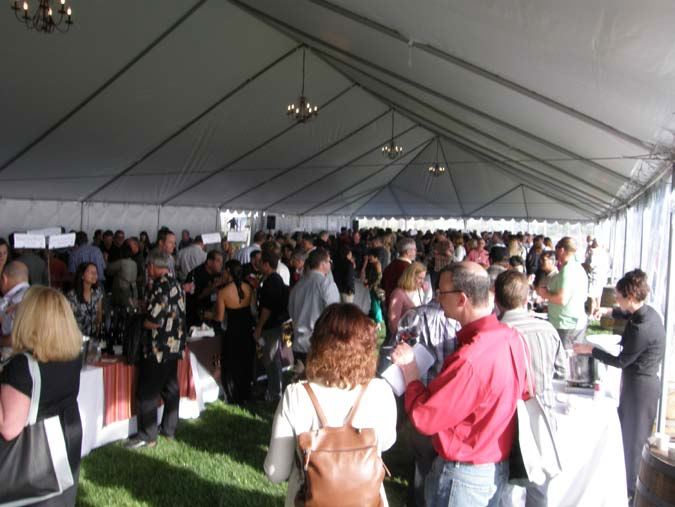
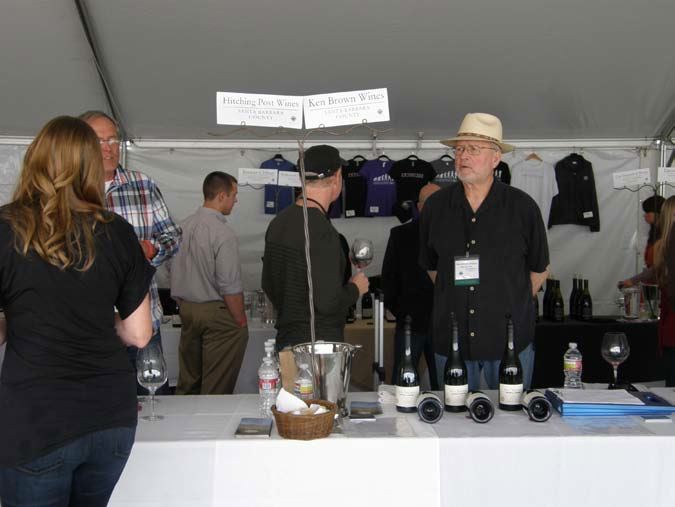
 There were a number of seminars that were recorded and will be available for listening in the coming weeks at Grape Radio, www.graperadio.com, and the World of Pinot Noir website, www.wopn.com: “Not Pinot Blanc, Not Pinot Gris - It’s White Pinot Noir!” Moderator Master Sommelier Fred Dane, Panelists Gary Horner (Erath), Jim Prosser (J.K. Carriere) and Zak Miller (Domaine Carneros) “Up Close and Personal with Kosta Browne” Moderator Master Sommelier Fred Dane, Panelists Michael Browne, Dennis Koplen and Gary Pisoni “Pinot Noir on the Rocks - The Question of ‘Minerality’” Moderator Karen MacNeil, Panelists Fintan du Fresne (Chamisal), Jason Jardine (Flowers), Mike Waller (Calera) and James Cahill (Soter Vineyards) “Alcohol and Balance Redux, and How Vintage Comes Into Play” Moderator Karen MacNeil, Panelists Jim Clendenen (Au Bon Climat), Adam Lee (Siduri), Greg Brewer (Melville), Joe Davis (Arcadian) and Wells Guthrie (Copain) “Terroir: the Soul of La Côte d’Or” Don Kinnan, CSS, CWE, lead instructor for the French Wine Society’s Master Burgundy Certificate presents a seminar on the wines, soils, climate and history of the Côte d’Or.
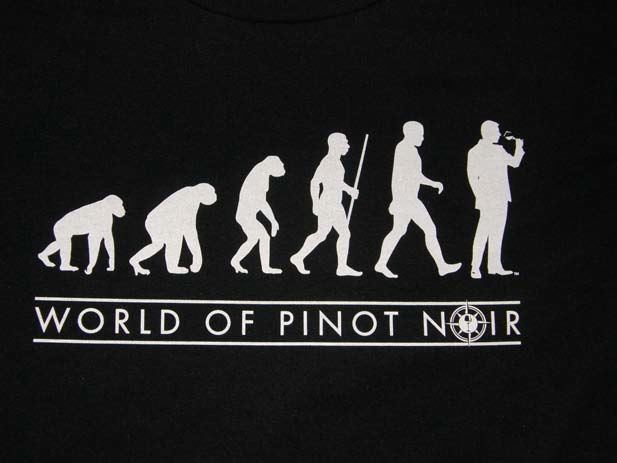 The buzz at this year's WOPN revolved around a few topics: (1) Pinot Noir Blanc - a fad that is a curiosity but certainly holds no long term interest; (2) Increasing use of some whole cluster fermentation - a trend that is highly dependent on vintage, vineyard and other factors; (3) The challenges of the 2011 vintage which was just plain cool and not in a good way - intensive work in the vineyard was required to save the vintage; (4) The challenge of adapting oak regimens to each vintage - barrels must be ordered in advance before vintage weather plays out; (5) Interest in the alcohol percentage and balance debate has faded. I sampled many Pinot Noir wines both in the tents at Friday and Saturday’s Focus Tastings by the Sea and in the media room. Most wines offered were from the challenging 2010 and 2011 vintages. Although only tasted briefly, the following wines made an impression on me (no particular order) RN Estate Vineyard & Winery Roger Nicolas has established a winery of note that features Rhone and Bordeaux varietals grown on a ridge six miles north of Paso Robles and Pinot Noirs sourced from cooler regions of the Central Coast. The Pinot Noirs are crafted in small lots in a food-friendly style that appeals to me. Roger was offering a vertical of Fiddlestix Vineyard Sta. Rita Hills Pinot Noir, 2009, 2010 and 2011.
2009 RN Estate Fiddlestix Vineyard Sta. Rita Hills Pinot Noir 270 cases. · Very elegant, restrained and charming with impeccable balance. Very good.
2010 RN Estate Fiddlestix Vineyard Sta. Rita Hills Pinot Noir 240 cases. · Because of the heat spike at harvest, this is a riper, showier and bolder wine with a very long finish. Very California in style. Good.
2011 RN Estate Fiddlestix Vineyard Sta. Rita Hills Pinot Noir 195 cases. Bottled 8/12. · Still very young but showing the best features of 2009 and 2010. Wines from Fiddlestix are often tannic but the tannins are beautifully tamed in this vintage. Look for this release soon. Very special.
2011 RN Estate Solomon Hills Santa Maria Valley Pinot Noir 13.3% alc., 205 cases, $55. Clones 115, 667 and 5. Aged 10 months in 40% new French oak barrels. · Drinking beautifully now with aromas and flavors of fresh red berries, spice and earth. Very elegantly styled with gossamer tannins and complimentary tobacco oak in the background. Very good.
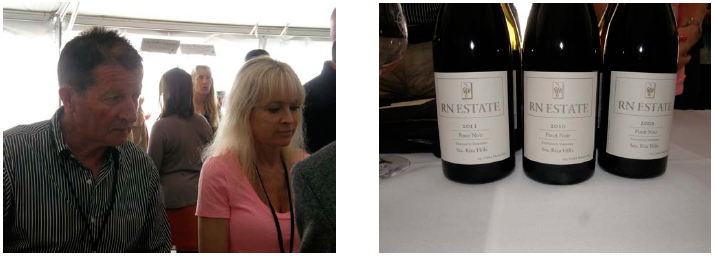 La Rochelle This Livermore Valley winery is doing a commendable job with Pinot Noir sources throughout California and Oregon including Soberanes, Sleepy Hollow, Rosella’s, Donum Estate, Londer, Paraiso, Tondre Grapefield, Ferrington, Savoy and Deer Park vineyards.
2010 La Rochelle Donum Estate Carneros Pinot Noir $N/A. La Rochelle is the only winery producing a vineyard-designate from this prestigious site. · Aromas of wild berries, leading to flavors of blackberries and black plums accented with spice. Nicely integrated tannins and impressive finishing power and length. Exceptional.
2010 La Rochelle Soberanes Vineyard Santa Lucia Highlands Pinot Noir $N/A. · Similar flavor profile to the Donum Estate bottling, but lighter, more refined, and exhibiting a very crisp and juicy character. Very good.
Paul Lato Wines I visited Paul just before WOPN and tasted some of his 2011 Pinot Noirs that have now been released, and as always, sold out. I will report on these wines and a few more that I have yet to taste in an upcoming issue. Paul’s wines are all about harmony and elegance, produced from very carefully managed vineyard blocks with low yields.
2009 Paul Lato "Lancelot" Pisoni Vineyard Santa Lucia Highlands Pinot Noir 3 Liter! · Remarkable elegance for a Pisoni Vineyard Pinot Noir with juicy, perfectly ripe black plum aromas and flavors caressed by very lacy tannins. I called it “Pisoni unplugged.” Exceptional.
 Keefer Ranch Wines A family owned and farmed vineyard and winery in the Green Valley sub appellation of the Russian River Valley. I have found the wines consistently superb from this well-known vineyard that also supplies grapes to top notch Pinot Noir producers such as Kosta Browne and Siduri.
2010 Keefer Ranch Wines Russian River Valley Pinot Noir $42. Fourth vintage. Swan and Dijon 115. Aged 17 months in 40% new French oak barrels. · This wine really stands out for its juicy crispness and icy cherry flavor. A real charmer in every way and the best Keefer Ranch wine from this vintage that I have had. You want this one. Exceptional.
Left Coast Cellars Located in the Willamette Valley in Rickreall, Oregon, winemakers Luke McCollom and Joe Wright (pictured below) source from estate vineyards planted to Dijon, Pommard and Wädenswil Pinot Noir clones. Farming practices are organic and sustainable to encourage the vitality of the vines in the rocky, shallow soils. The estate grown Pinot Noirs are superb and the White Pinot Noir and Rosé of Pinot Noir are exceptional.
2012 Left Coast Cellars Willamette Valley White Pinot Noir 13.5% alc., 200 cases, $20. Aged 5 months in 100% stainless steel. Free-run white juice from Pommard and Wädenswil Pinot Noir grapes. · Aromatic lust featuring bright scents of peaches, pear, mango and honey. Crisp, vivacious and thoroughly pleasing. The best white Pinot Noir I tasted at the event. Exceptional.
2012 Left Coast Cellars Willamette Valley Rosé of Pinot Noir 13.0% alc., 275 cases, $18. Dijon 667 and 777 clones. A saigneé of 100% Pinot Noir. Aged 5 months in 509% neutral French oak barrels and 50% in stainless steel. · Thoroughly pleasing aromas and flavors of red cherries and strawberries with a citrus underbelly. Fresh, bright unplugged Pinot Noir fruit. Drinks like a white wine so benefits from chilling. Very good.
2008 Left Coast Cellars Right Bank Willamette Valley Pinot Noir 14.1% alc., 273 cases, $35. 100% Pommard clone. Aged 22 months in 30% new French oak barrels. · Very expressive wine with dark red fruit aromas and flavors, middleweight size, nicely composed with fine-grain tannins and a generous finish. Very good.
14.0% alc., 254 cases, $35. Dijon 114, 115, 667 and 777. Aged 18 months in 70% new French oak barrels. · A solid offering with plenty of appealing cherry and spice, balanced nicely with ripe tannins and a bright acid spine. Good.
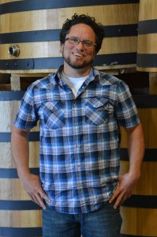 Ken Brown Wines Ken has been making wine for more than 35 years at Zaca Mesa, Byron Winery and now Ken Brown Wines. He produces small lots of Pinot Noir, Chardonnay and Syrah from top vineyards in the Sta. Rita Hills and Santa Maria Valley. Total production is 2,000 cases. What impresses me about Ken is that he offers his wines proudly at many events, and is always present to patiently answer questions, never sending a stand-in despite years of wine event participation.
2010 Ken Brown Wines Sta. Rita Hills Pinot Noir 14.5% alc., pH 3.71, TA 0.56, 298 cases, $40. From Rio Vista (78%), Rita’s Crown and Rancho La Vina vineyards providing an over view of the Sta. Rita Hills AVA. 100% de-stemmed, aged 10 months in 37% new French oak barrels. · This is a very forward drinking wine that will find wide appeal. It is aromatically expressive with scents of black cherry and spice, echoed on the palate which is discreetly lush and pleasing. Beautiful integration of oak and seductively elegant. Very good.
2010 Ken Brown Wines Clos Pepe Vineyard Sta. Rita Hills Pinot Noir 14.7% alc., pH 3.57, TA 0.61, 265 cases, $50. Pommard clone. 100% de-stemmed, aged 18 months in 43% French oak barrels. · Red and black fruits are featured in this very feminine expression of this vineyard. Nicely balanced with restrained tannins. Demonstrates a wet rock aroma and a mineral-driven electric component on the palate. Very good.
2010 Ken Brown Wines Cargassachi Vineyard Sta. Rita Hills Pinot Noir $N/A. Clone 115. · Very representative of this vineyard with black fruits, an earthy and animale component and a deep richness on the palate. The ripe, muscular tannins will benefit from more bottle aging. Good
Domaine Carneros The still Pinot Noir wines from this sparkling wine producer owned by the Taittinger family are hidden gems. This winery began Pinot Noir production in 1992, but in recent years winemaker Eileen Crane has been offering exceptional Pinot Noir from the estate’s 138 acres of certified organic vineyards. The estate offering is a solid everyday drinker and the limited release The Famous Gate and Avant-Garde bottlings are worth exploring.
2010 Domaine Carneros La Terre Promise Carneros Pinot Noir 14.4% alc., $N/A. From the Domaine’s newest estate vineyard. Organic grapes. · Moderately dark reddish-purple color in the glass. Aromas of black cherries, black raspberries and spice with a hint of stem in a good way. A savory wine with mushrooms and tobacco notes complimenting the middleweight berry and cherry flavors. Nicely balanced with supple tannins. Good (+).
Papapietro Perry A specialist in small lots of single-vineyard Pinot Noir and Zinfandel produced from the Russian River Valley, Anderson Valley, Sonoma Coast and Dry Creek Valley. One of the premier producers of Pinot Noir in California. As I was tasting through a number of wines and came upon the Papapietro Perry Pinot Noirs, it was immediately evident that these wines were a step up in quality.
2010 Papapietro Perry Campbell Ranch Sonoma Coast Pinot Noir 14.5% alc., Unreleased. · Moderate reddish-purple color in the glass. Lovely aromas of fresh strawberries, cherries and wood spice. Enchanting and flavorful, featuring spicy cherries and complimentary oak. Not big and hedonistic, but has an electric vibe. Very good.
2010 Papapietro Perry Nunes Vineyard Russian River Valley Pinot Noir 14.0% alc., Unreleased. · Medium reddish-purple color in the glass. Fragrant with fresh rose petals and cherry pie. Elegant and balanced, with delicious flavors of black cherries, cola, spice and subtle oak. Very good.
Keller Estate Located in the Petaluma Gap region of the Sonoma Coast, this winery produces estate grown wines including Chardonnay and Pinot Noir. The 650-acre ranch was first planted to Chardonnay in 1989 and Pinot Noir in 1999. The Keller Estate label appeared in 2000 under the direction of Ana Keller. In addition, many vineyard-designated wines have been produced from the estate La Cruz Vineyard by top wineries such as Arista, La Rochelle and Zapaltas.
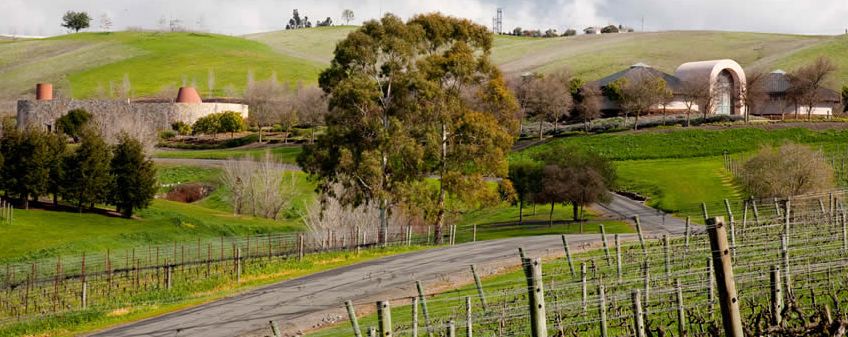
2010 Keller Estate La Cruz Vineyard Sonoma Coast Pinot Noir 14.2% alc., $45. · Moderately light reddishpurple color in the glass. Aromas of lean red fruits with a subtle green herb note in the background. The flavors echo the nose. Light, soft and smooth. Decent.
2010 Keller Estate El Coro Sonoma Coast Pinot Noir 14.2% alc., $52. This is the sibling wine to the Keller Estate La Cruz Vineyard Pinot Noir. The grapes are sourced from a highly elevated block on a ridgetop which is more exposed to the maritime winds. Soils are thin loamy clay with a volcanic underlay. Unfined and unfiltered. · Medium reddish-purple color in the glass. Lovely perfume of dark red cherries and berries that really draws you into the glass. This is a wine of character and nuance offering something different with each sip including deep cherry flavor with hints of savory herbs and oak. One of the most memorable wines I tasted at this event. Exceptional.
2010 Keller Estate Precioso Sonoma Coast Pinot Noir 14.3% alc., $75. A barrel selection representing the best of the estate in the vintage. · Medium reddish-purple color in the glass. Very aromatic with hi-tone scents of red berries on the vine and sandalwood. Very soft and gracious in the mouth with delicious flavors of dark red and purple berries clothed in soft tannins and offering noticeable length on the finish. Exceptional.
J Vineyards & Winery This winery has a 25 year legacy in the Russian River Valley. Known for its stellar sparkling wines, Winemaker Melissa Stackhouse and Founder and President Judy Jordan are also dedicated now to producing serious, terroir-driven Pinot Noirs from estate vineyards in the Russian River Valley and Sonoma Coast.
2010 J Vineyards Freestone Hill Russian River Valley Pinot Noir 14.2% alc., 145 cases, $N/A. · Moderately light garnet color in the glass. Dark fruit aromas and flavors with hints of dark chocolate, cola and maple syrup. A bit brooding and murky with a touch of heat evident. Good.
2010 J Vineyards Estate Grown Robert Thomas Vineyard Russian River Valley Pinot Noir 14.5% alc., 620 cases, $60. · Moderately dark reddish-purple hue in the glass. Darker stone and berry fruits are featured with attractive spice and anise. Very smooth in the mouth with notable fruit intensity on the finish. Very good.
2010 J Vineyards Barrel 16 Russian River Valley Pinot Noir 14.5% alc., 400 cases, $N/A. · Moderately light reddish-purple color in the glass. The nose offers aromas of red fruits with a hint of espresso oak. Delicious mid palate attack of perfectly ripe black cherry fruit with a hint of spiced plum. Very impressive mid weight wine with a long and glorious finish. Very good.
More Pinot Noir. Remember that not every wine has to be exceptional to be enjoyed. New York Times wine writer and critic, Eric Asimov, notes (The World of Fine Wine Issue 39, 2013), “We need to pay greater attention to wines intended for drinking rather than to wines that will be collected.”
2011 Bruliam Soberanes Vineyard Santa Lucia Highlands Pinot Noir 13.9% alc., $N/A. · Moderately light reddish-purple color in the glass. The nose and flavors are currently dominated by oak-driven notes of coffee and mocha but there is an enticing core of fruit under cover. Soft in the mouth with gentle tannins. Give this wine more time for the oak to integrate. Decent.
2009 Landy Family Vineyards Estate Russian River Valley Pinot Noir 14.5% alc., 610 cases, $46. · Dark reddish-purple color in the glass. A big, lush wine featuring ostentatious black cherry fruit supported by firm tannins. Not for the squeamish. Good.
2010 Dierberg Estate Grown Santa Maria Valley Pinot Noir 14.0% alc., $42. · Moderately dark reddishpurple color in the glass. A very earthy wine featuring aromas and flavors of blackberries, pine and oak. Very soft in the mouth with gentle tannins. Good.
2009 Saintsbury Brown Ranch Carneros Pinot Noir 14.0% alc., $60. Planted to Dijon clones in 1992. · Moderate reddish-purple color in the glass. Interesting nose with aromas of alpine strawberries, black cherries, mint, forest and cut flowers. Very savory on the palate with mushroom and earth notes, dark stone and berry fruit, and a supporting cast of firm tannins. Very dry on the finish. Good.
2011 Failla Occidental Ridge Vineyard Sonoma Coast Pinot Noir 13.5% alc., $N/A. · Moderately light reddish-purple color in the glass. Nicely perfumed with cherries and red rose petals. The flavor doesn’t match the aroma, offering highly delicate red fruits backed by very lacy tannins. Shallow but pleasant. Decent.
2009 Center of Effort Rossa Corsa Edna Valley Pinot Noir $N/A. Clones 115 and 23. 100% whole cluster. Aged 19 months in once-filled French oak barrels. Unfined and unfiltered. · Deep, dark purple color in the glass. Aromas of blackberry jam and brioche. Very soft, even mushy on the palate, with very ripe flavors of plums, blackberries, currants and raisins. Finishes with a little heat. Decent.
2010 Big Basin Vineyards Alfaro Family Vineyard Santa Cruz Mountains Pinot Noir 13.4% alc., 150 cases, $44. Whole berry plus 30% whole cluster, indigenous yeast fermentation. Aged 16 months in 50% new French oak barrels. Unfined and unfiltered. · Moderate reddish-purple color in the glass. The nose is riveting, pulling you in with bright aromas of black raspberries and spice. Very lovely and plush on the palate with a seamless array of dark berry fruits, finishing with a satiny display of beautiful fruit. A captivating wine and one of the best I sampled at this year’s WOPN. Exceptional.
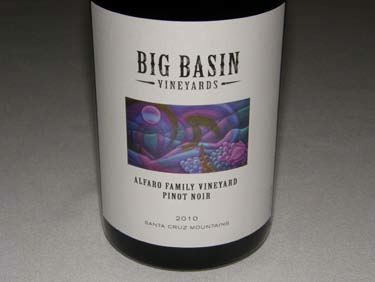
2010 Zotovich Cellars Estate Grown Sta. Rita Hills Pinot Noir 14.3% alc., 550 cases, $N/A. · Moderately light reddish-purple color in the glass. Slightly pungent aromas with noticeable oak. Soft on the palate with tasty, light weighted dark berry and plum fruit flavors, somewhat buried in oak. Decent.
NV R2 Wine Company Black Pine California Pinot Noir 1033 cases, $26. A blend of Anderson Valley, Carneros and Sonoma Coast fruit. Winemaker is Byron Kosuge. · A very solid, value priced Pinot Noir offering good concentration of dark red and black fruits with well integrated oak and nicely managed tannins. A perfect everyday drinker. Good.
2010 La Fenêtre Bien Nacido Vineyard Santa Maria Valley Pinot Noir 13.9% alc., 375 cases, $49. Backbone is from G block, one of the own-rooted sections of the vineyard planted in 1973. The remainder is a mix of clone 115 and 777 from N and Q blocks. Aged 18 months in French oak barrels. · Medium reddishpurple color in the glass. Hi-tone aromas of fresh cherries and dried rose petals. Very soft and seamless on the palate, with a flavorful core of black cherries and spice. Very good.
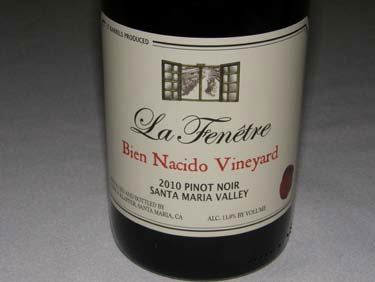
2010 La Fenêtre Presqu’ile Vineyard Santa Maria Valley Pinot Noir 13.7% alc., 350 cases, $49. Vineyard planted in the late 1990s when it was called Addamo. All clone 777. 30% whole cluster. Aged 18 months in French oak barrels. · Moderately dark reddish-purple color in the glass. Aromas of black cherries, briar and oak. A brooding wine with discreetly concentrated flavors of dark cherries and berries with a juicy, uplifting finish. Good.
2011 Frank Family Vineyards Lewis Vineyard Reserve Napa Carneros Pinot Noir 14.7% alc., pH 3.87, TA 0.59, $57.50. Aged 9 months in 35% new and 65% once and twice-filled French oak barrels. · Moderately dark reddish-purple color in the glass. Very aromatic featuring bright scents of black raspberries and exotic spices. Full-bodied core of lush raspberry fruit with an imposing oak imprint, finishing with a bit of heat. Decent.
2010 Foley T Anchor Ranch Sta. Rita Hills Pinot Noir 14.5% alc., $N/A. · Moderately dark reddish-purple hue in the glass. Aromas of spiced cherries, black raspberries and a hint of stem. Juicy, with vibrant fruit, a savory note in the background, a seductive mouth feel and commendable restraint. Very good.
2010 Foley Bar Lazy S Ranch Sta. Rita Hills Pinot Noir 14.5% alc., $N/A. · Medium reddish-purple color in the glass. Ripe dark red fruits with a hint of stem. Earth-kissed black fruits with a dose of dark chocolate on the palate. Smooth with balanced tannins and a generous finish. Very good.
2011 Hartford Court Russian River Valley Pinot Noir 14.5% alc., $N/A. · Moderate reddish-purple color in the glass. Very aromatic with scents of cherries, raspberries, cola, spice and biscuit. Rich, full-bodied cherry core with a hint of cola. Very soft, almost mushy on the palate. Good.
2010 Hartford Court MacLean’s Block Russian River Valley Pinot Noir 14.8% alc., $60. From a 14-yearold vineyard near Occidental planted in Goldridge soil. Unfined and unfiltered. · Moderate reddish-purple color in the glass. Very fruity nose featuring dark cherry pie glaze. Dense, super ripe fruit profile with notes of raisin and currant. Somewhat brooding and rustic with firm tannins. Decent.
2010 Landmark Kanzler Vineyard Sonoma Coast Pinot Noir 14.4% alc., $N/A. · Moderately dark reddishpurple color in the glass. Perfume of grapes and spice. A fruit-driven wine with intense dark berry and plum fruit flavors caressed by soft tannins. Very smoothly textured with a slightly hot finish. Decent.
2010 Flying Goat Cellars Solomon Hills Vineyard Santa Maria Valley Pinot Noir 13.1% alc., $N/A. · Moderately light reddish-purple color in the glass. Aromatic with appealing scents of dark red fruits, rose petals and herbs. A delicate, refined wine offering savory red fruits and a crisp cut of underlying acidity. On the lean side and composed of barely ripe fruit, but a reflection of the vintage and an easy drinker that is food friendly. Good.
2010 Flying Goat Cellars Bien Nacido Vineyard Santa Maria Valley Pinot Noir 13.7% alc., $N/A. · Medium reddish-purple color in the glass. I was really drawn to the nose on this wine which offered scintillating aromas of spicy cherries. The cherry flavors don’t quite have the impact of the aromas but the wine is nicely balanced and very smooth in the mouth. Good.
2010 Flying Goat Cellars Rio Vista Vineyard Sta. Rita Hills Pinot Noir 14.5% alc., $N/A. · Moderately dark reddish-purple color in the glass. Black cherries are the theme in this middleweight wine with good fruit concentration. Well-managed tannins and a refreshing kiss of cherry on the finish. Good.
2010 Cartograph Floodgate Vineyard Russian River Valley Pinot Noir pH 3.67, 196 cases, $40. · Moderately light reddish-purple color in the glass. Aromas of red cherries, cranberry and sandalwood. Light and delicate, but flavorful, featuring dark red cherry and berry flavors backed up by brisk acidity. The pedigree of this established vineyard shows through. Very good.

Finding the Central CoastThe Central Coast AVA, established in 1985, is vast, stretching 250 miles along the California coastline from the San Francisco Bay to Santa Barbara County. It is the largest AVA in California, encompassing six counties, and averaging 25 miles in width, stretching over 4 million (or 5 million depending on the source) acres with 90,300 to 100,000 acres (again, depending on the source) planted to wine grapes. 50% of the plantings are Chardonnay. There are approximately 600 wineries, producing 15% of the state’s wine production. 30 smaller sub-AVAs reside within the large Central Coast AVA.
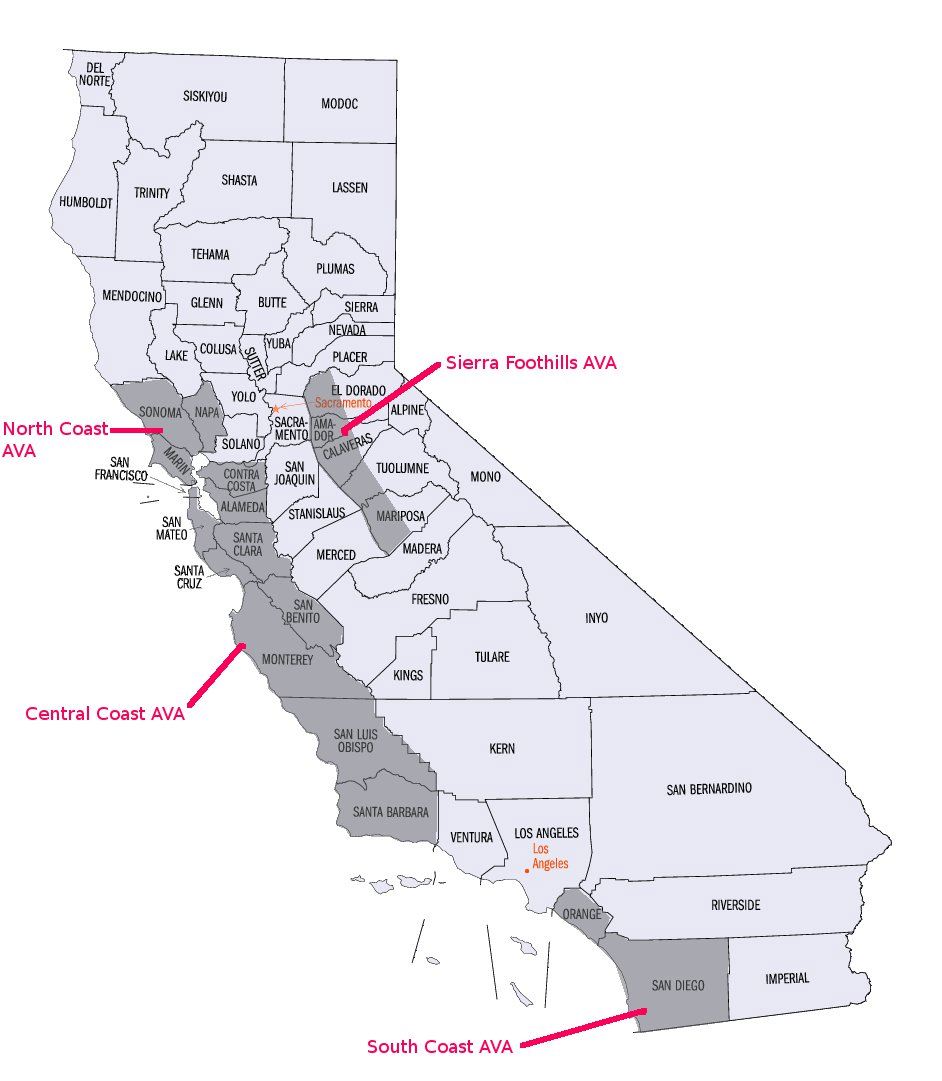 Not surprisingly, consumers are confused about the Central Coast. Andrew Adams, writing in Wines & Vines (March 19, 2013), noted that Michael Heintz, the senior marketing director for E. & J. Gallo reported, “Surveys of consumers found the term “Central Coast” often left them confused or thinking of the central coast areas nearest to where they lived.” Some consumers thought Paso Robles and San Luis Obispo were in Mexico! It might be prudent for World of Pinot Noir to change its name to Central Coast Pinot Noir Festival and limit the wines to those produced in the Central Coast AVA or wines made from grapes grown in the Central Coast AVA. The Grand Tasting venue could be divided into, for example, Santa Lucia Highlands & Monterey County, San Luis Obispo including Arroyo Grande and Edna Valley, Santa Maria Valley and Santa Rita Hills. The Pinot Noirs from each of these regions do have some regional characteristics and this could be emphasized to the attendees. I believe regional identity is a key factor in consumer wine buying decisions. One of the challenges of the Central Coast is that it is largely agricultural and lacks the infrastructure for tourism found in popular California wine tourism appellations such as Sonoma County and Napa County. Santa Cruz Mountains does have many lodging and restaurant choices, but the wineries are spread out, many wineries are open infrequently or not at all, and the region does not condone proper signage that would make it more convenient to find winery locations. San Luis Obispo has some limited tourism infrastructure and is reasonably close to Edna Valley and Arroyo Grande. Santa Maria Valley is lacking but is only a thirty minute drive from good lodging and restaurant choices in the Santa Ynez Valley. Santa Rita Hills is reasonably close to Santa Ynez and Buellton. After the World of Pinot Noir, I spent a morning with James Ontiveros, owner of Rancho Ontiveros Vineyard in the Santa Maria Valley and Native 9 Wines, partner in Alta Maria Winery with winemaker Paul Wilkins, and Director of Sales and Marketing at Bien Nacido Vineyard, Solomon Hills Vineyard, French Camp Vineyard and Central Coast Wine Services. He is a 9th-generation land owner whose ancestors owned the 8,900-acre Rancho Tepusquet land grant in northern Santa Barbara County. A graduate of Cal Poly San Luis Obispo, James has spent much of his life in the Central Coast. I jumped in his car, and with his family dog on my lap, we set off to view the vineyards and wineries of the Santa Maria Valley. I learned a bit of history of the region as well. We traversed both the Eastern and Western portions of the east-west transverse valley and river lands, a huge alluvial plain cut out by the Santa Maria River. This transverse valley is responsible for the suitability of the Santa Maria Valley AVA for wine grape growing. Cool maritime influences are channeled into the wide valley, and if the Santa Maria Valley was not situated at this southerly latitude, it would be too cool to ripen grape varieties to full maturity. The combination of maritime winds and fog produces a long growing season averaging 125 days from bloom to harvest. The daytime temperature rarely exceeds 75º F and it is rare for the AVA to receive enough excessive heat to shut down the vines. The map below can be seen full size at www.santamariavalleywinecountry.com. Looking at the map, one can appreciate that there is still a vast amount of undeveloped prime vineyard land that is currently being used for cattle grazing and other agricultural pursuits.
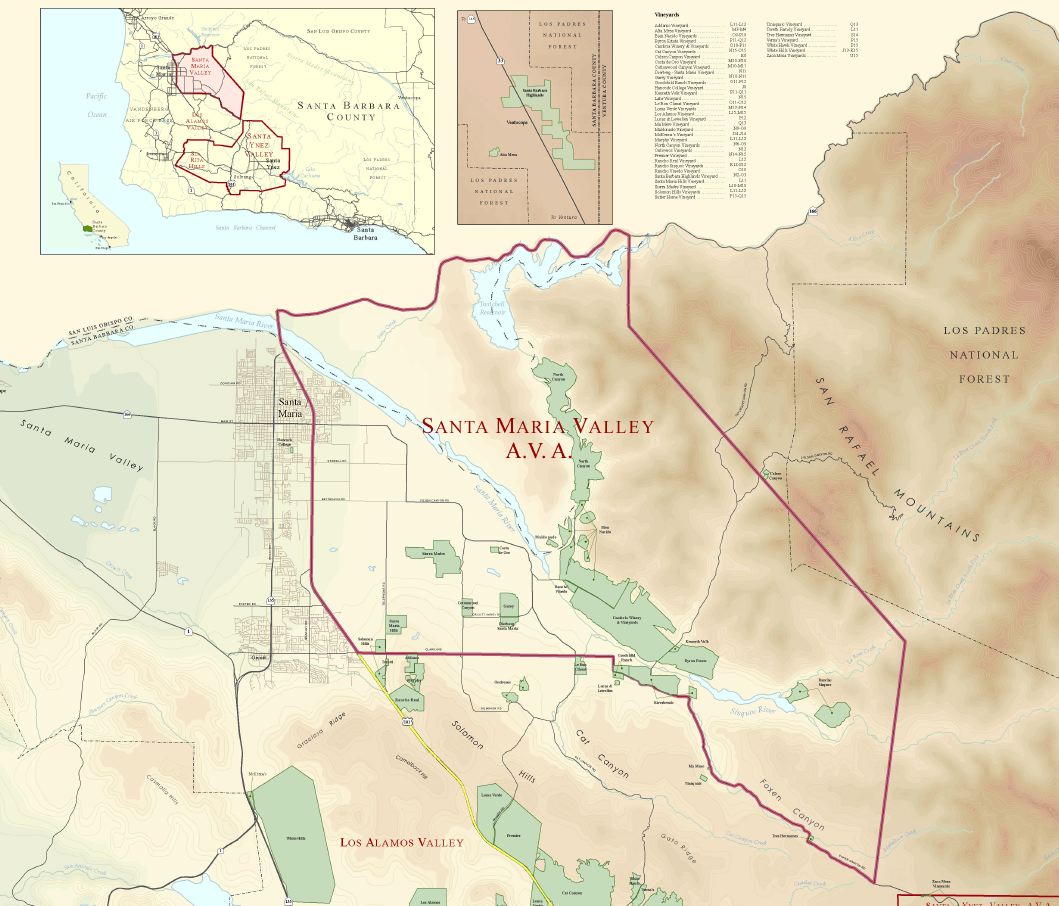 The most striking new development in the Santa Maria Valley is the widespread replacement of old vines originally planted in the early 1970s. The replacement of old vines varies from hundreds of acres at Cambria and Byron to more modest re-plantings at vineyards like Bien Nacido and Clark and Telephone. The Nielson Vineyard at Byron is the oldest commercial vineyard in Santa Barbara County and was planted in 1964, but is now being replaced with the newest rootstocks and clones, taking advantage of modern viticulture knowledge and years of winegrowing experience in the Santa Maria Valley. James pointed out how the newer plantings in the valley are being laid out with more consideration of aspect and topography. Some would decry the loss of old vines, but James responds that the much of the old vine acreage had been under performing and underwhelming. “Small blocks of old vines are interesting, but we don’t need thousands of acres.” While attending Cal Poly San Luis Obispo, James met Paul Wilkins. They started the campus Vines & Wines Club modestly with only twelve members. After graduating from college, James went to work for E. & J. Gallo in Sonoma County, unaware that the Vines & Wines Club had become the most popular club on campus. He received a call from one of the club’s members asking permission for a group to visit Gallo. James didn’t think to ask exactly how many people would attend. On the day of the visit, two busloads of college kids showed up. 70% of the club had become girls and James was suddenly confronted with a “Girls Gone Wild” scenario. Paul became a winemaker after college, and in 2005, he and James became partners in Alta Maria Winery & Vineyards. Alta Maria Pinot Noir is intended to be a reasonably priced “snapshot of the Santa Maria Valley.” James has gradually locked up long-term sources for grapes for Alta Maria including Bien Nacido, Rancho Sisquoc, and Garey Vineyard. James is most excited about the newest Alta Maria vineyard source. He has obtained a long term lease with an option to buy the 27-acre vineyard, Rancho Vinedo, located adjacent Bien Nacido Vineyard and possessing very similar soils (the vineyard site is visible on the map above). The vineyard was originally planted in 1972 and has been a source of grapes for Au Bon Climat. A family-run project, the vineyard has been slightly neglected and subjected to years of herbicides. James is upgrading the farming to organic, altering the pruning and trellising regimen, interplanting, and converting some of the Chardonnay back to Pinot Noir. Many years ago, Jim Clendenen and Adam Tolmach advised the vineyard owners to graft a portion of the Pinot Noir over to Chardonnay. Some of those vines are now being refocused by James to return them to Pinot Noir production, giving him 42-year-old own-rooted Pinot Noir vines. Remarkably, the vineyard was part of the Ontiveros family’s original ranch, so in essence, he is “slowly taking it back.” A new name for the vineyard is under consideration. We drove to Rancho Sisquoc, the site of previous Santa Barbara County Harvest Festivals. At the eastern edge of the Santa Maria Valley, the property spans an astounding 36,000 acres of which 300 acres are planted to vineyards. This area is less windy and warmer in some parts allowing varieties such as Cabernet Sauvignon, Merlot, Syrah and Sauvignon Blanc to be successfully grown there. The Flood family, who were notable silver kings in Nevada, have owned the property since the early 1970s. James worked as a cowboy on the ranch while a student at Cal Poly San Luis Obispo. The Ranch Sisquoc winery tasting room is a real throwback to the early ranching days of the Santa Maria Valley and with the cattle headquarters adjacent, one sees cowboys and winemakers intermingling. Our final stop was Presqu’ile Winery, located on Clark Road, on the western side of the Santa Maria Valley close to Solomon Hills and Clark & Telephone vineyards. This is a remarkable property, when completed in June 2013, will become the jewel of the Santa Maria Valley AVA. Presqu’ile (“press-KEEL”) is owned by the Murphy Family who named the winery Presqu’ile, after the Creole word meaning “almost an island.” The reference is to the gathering place of the Murphy family on the Gulf Coast until Hurricane Katrina ended an era. Four generations of the Murphy family have partnered in farming, forestry, oil and gas, and conservation. Today, two generations of Murphys have joined with winemaker Dieter Cronjie and vineyard manager Jim Stollberg to form the soul of Presqu’ile. The 73 acres of certified sustainably farmed vineyards are located on a 200-acre property. The Murphys have added to the initial plantings of the previous Addamo vineyards on the site. Pinot Noir, Chardonnay, Sauvignon Blanc and a little Nebbiolo make up the vineyard composition. Beginning with the 2010 vintage, most of the Presqu’ile wines became estate grown. James took me on a tour of the new visitor center, caves and winery built into a hillside. Although still under construction, the facility is already stunning with a tasteful modern architectural presence, and a large gravityflow winery outfitted with all the latest winemaking technology. Visitors will be taken from the caves by elevator to an entertainment venue that offers a breathtaking view of the entire Santa Maria Valley. This will undoubtedly become the first stop for visitors to the Santa Maria Valley and significantly increase the awareness among consumers of the magnificence of the wines from the Santa Maria Valley.
 The Murphys have become partners in Alta Maria Winery & Vineyards and the Alta Maria vines will be produced at the new Presqu’ile winemaking facility. Matt Murphy (cap), Jonathan Murphy (jacket) and Dieter Cronjie (gray sweater) are pictured. Visit www.presquilewine.com and www.altammaria.com.
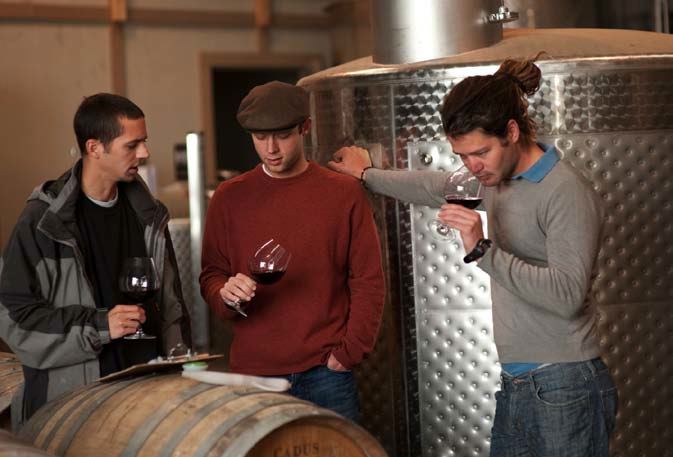
2010 Alta Maria Vineyards Santa Maria Valley Pinot Noir 14.3% alc., pH 3.69, TA 0.53, 4200 cases, $28. Aged 17 months in 33% new French oak barrels. Sixth vintage. · Moderate reddish-purple color in the glass. Nicely perfumed with aromas of cherries, berries, red plum and spice. Mid weight pleasing flavors echo the nose. The “Santa Maria” spice component is vivid and quite evident on the finish. A well-crafted wine perfect for the dinner table. Good (+).
2011 Byron Santa Maria Valley Pinot Noir 13.5% alc., pH 3.74, TA 0.50, 15, 207 cases, $29. 100% estate-owned Nielson Vineyard fruit. This wine comes from both older Pinot Noir vines planted on their own rootstock and new vines planted to high density spacing with the latest clones and rootstocks. Aged 10 months in 20% new French oak barrels. · Moderately dark reddish-purple color in the glass. Very appealing aromas of black raspberries, black plums, spice, pine and nutscented oak. Mid weight flavors of dark berries, cherries and plums with pleasing hints of cola, spice and herbal oak. A little earthy tone fills the background. This wine is noticeably lighter, fresher and crisper in this vintage. Good (+).
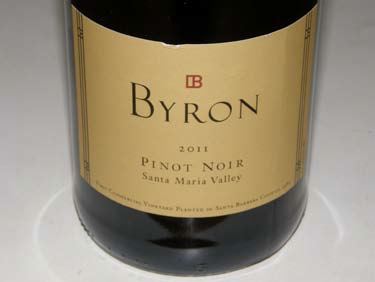
2011 Byron Santa Barbara County Pinot Noir 13.0% alc., pH 3.65, TA 0.50, $19. Aged 10 months in 20% new French oak barrels. · Moderate reddish-purple color in the glass. Very fragrant with an array of aromas including dark berries, spice, Hoison, cigar box and oak. Flavorful plum and boysenberry fruits with complimentary toasted and tobacco-imbued oak in the background. A middleweight style with balanced tannins and easy drink ability. Very good concentration for the vintage. A respectable representation of the Santa Barbara County region and an excellent valuepriced wine for everyday drinking. Good.
2010 Cambria Estate Winery Julia’s Vineyard Santa Maria Valley Pinot Noir 14.6% alc., pH 3.59, TA 0.54, $25. Clones 4, 2A, 23, 667, 115, 12, 5 and 777. Aged 8 months in 26% new French oak barrels. Week-long cold soak for optimum color and flavor extraction. · Moderately dark reddishpurple color in the glass. Beautifully perfumed with aromas of boysenberry pie glaze, dark cherries, black grapes, spice and just a hint of mocha. Very tasty core of moderately dark red, blue and black berries with an earthy undertone, well-integrated oak and a polished mouth feel. A quintessential Santa Maria Valley wine that has respectable power, good finishing length and enough spirit to be thoroughly satisfying. Very good.
2010 Cambria Bench Break Santa Maria Valley Pinot Noir 14.3% alc, $34. Sourced from the Bench Break Vineyard that has very shallow soils. Although this vineyard usually produces an opulent wine, the wine has more restraint in this vintage. Tasted at the World of Pinot Noir. · The nose is open and expressive with scents of fresh red and black cherries and berries. The fresh fruit flavors are enhanced by an earthy, grilled mushroom riff. Very smooth on the palate with restrained tannins and a bright black cherry finish. I like this a lot. Very good.
2009 Dierberg Estate Grown Santa Maria Valley Pinot Noir 14.5% alc., pH 3.81, $42 (often priced by retailers at $35). Dierberg Vineyard is situated on top a sandy loam mesa above the southern bank of the Santa Maria River, in the far western portion of the Santa Maria AVA. Its proximity to the ocean makes it one of the coolest vineyards in the AVA. Planted in 1997, the vineyard is planted to 11 different clones include 60% Dijon and 40% heritage types. 1 month on skins, aged 18 months in 33% new French oak barrels. Unfined and unfiltered. · Moderately dark reddish-purple hue in the glass. Penetrating aromas of black plum, blackberry, black currant and forest floor on the nose with a hint of oak. Impressive flavor attack on entry carrying through to a powerful fruitdriven finish. There are charming flavors of blackberries, Hoison sauce, anise and spice with well-managed oak in the background. Very soft on the palate with good supporting acidity. Much better later in the day from a previously opened and re-corked bottle. Very good.

2010 Presqu’ile Winery Presqu’ile Estate Vineyard Santa Maria Valley Pinot Noir 13.46% alc., TA 0.561, $55. First 100% estate grown wine. 100% whole cluster. 60% clone 777, 40% clone 667. Aged 17 months in 35% new French oak barrels. Tasted briefly at World of Pinot Noir. · Welcome whole cluster spice and structure with a delicious cherry core, fine tannins and a very focused finish. Very good.
2010 Presqu’ile Winery Solomon Hills Vineyard Santa Maria Valley Pinot Noir $/N/A 80% whole cluster. Tasted briefly at World of Pinot Noir. · Mid weight darker stone fruits, with good verve and zest. Layers of flavor backed by rigorous tannins. Good.
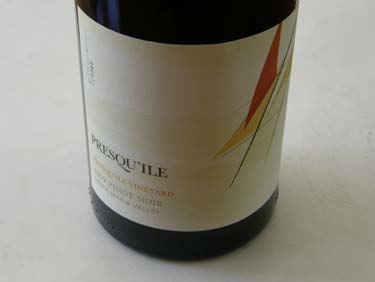 The Chardonnay Symposium: Tickets are now on sale for The Chardonnay Symposium in Santa Maria Valley July 19-21. The weekend full of events will include a Dinner Tribute to Jim Clendenen at the Historic Bien Nacido Adobe on Friday, July 19, and The Chardonnay Symposium and Grand Chardonnay Tasting at Byron Vineyard & Winery on Saturday, July 20. For tickets and information visit www.thechardonnaysymposium.com.
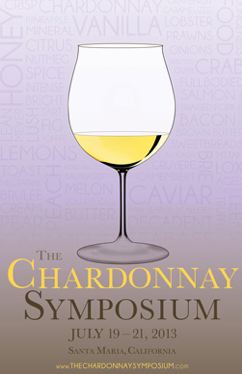
Pence Ranch: Promising New Central Coast Producer
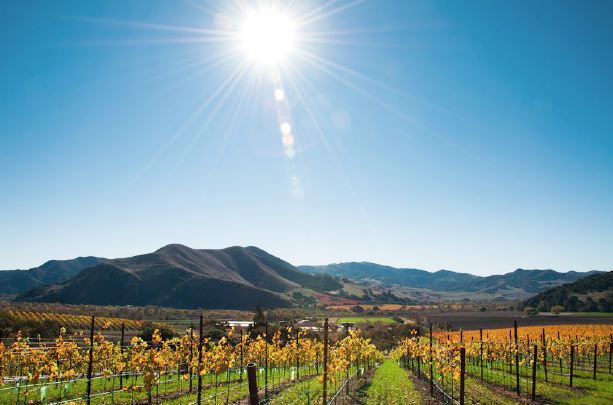 The Pence Ranch Estate Vineyard, part of a 200-acre working ranch and polyculture, is planted to Pinot Noir, Chardonnay and Grenache, just east of the Sta. Rita Hills AVA. The vineyard is situated on an elevated plateau that is fully exposed to the maritime winds and morning fog. It is the first vineyard in the region to incorporate advanced computer modeling in its design taking into account multiple soil types, sun exposures, drainage patterns and other elements. The result is 19 different blocks (10 currently producing) totaling 50.4 acres planted beginning in 2006. Comprising 12 different clones and 5 rootstocks, the vineyard includes both modern clones (Dijon 667, 115, 828, 459, and 777, and Pommard and 2A for Pinot Noir and Dijon 76 and Mt. Eden for Chardonnay) and heirloom selections (Swan, Mt. Eden), planted at a density of 1,815 vines per acre (8’ x 3’). The vines are spur pruned with unilateral cordon and vertical shoot positioning. Sustainable farming practices are employed throughout. The proprietors are Blair Pence and Holly Brooks. Pence has a long obsession with Pinot Noir and has traveled frequently to Burgundy to observe how grapes are farmed and vinified. He says, “I would be lying if I said my team and I do not have the highest aspirations for our vineyard and our wine program. When you pursue Pinot Noir seriously, you have to go big, or go home. We have spared no expense in developing our site. It is a purposeful vineyard, in that everything was done very deliberately to achieve the highest level of quality in our wines. Our philosophy is a non interventionist, site-driven one.” Vineyard management is under the direction of Francisco Ramirez, Stan Kadota and Daniel Garibay. The winemaker is veteran Jeff Fink, formerly a winemaker at Tantara. The Pence Ranch Estate is located just outside the Sta. Rita Hills AVA, so Pence has recently filed a petition with the TTB to extend the eastern boundary of the Sta. Rita Hills AVA to include Pence Ranch Vineyard as well as John Sebastiano Vineyard and Rio Vista Vineyard. The board of the Sta. Rita Hills Winegrower Alliance has opposed the expansion because the area has a north-south orientation in contrast to the current east-west orientation of the AVA and lacks the same maritime influence of the current AVA. Pence may need to initiate a proposal for a new AVA. Grapes have been sold in previous years to a number of Santa Barbara County wineries. The inaugural 2010 Pence Ranch Estate wines were sourced from five producing blocks. Average yields were 1.35 tons per acre. Harvest was between September 20 and October 12 (both before and after an intervening heat spike). Winemaking for the inaugural 2010 vintage was as follows. After night picking, the grapes were rigorously sorted in the vineyard and at the winery. Both native and inoculated fermentations were carried out in small open-top fermenters. Some whole cluster was used depending on ripeness of stems and the general health of the fruit. Free run juice was barreled directly from the fermenter. The press wine fractions were combined and barreled separately. The wines were aged in 1-year and older French oak barrels. Malolactic fermentation was indigenous. The wines were sometimes racked in summer after the completion of malolactic fermentation, with no further racking before bottling which occurred after 19 to 22 months in barrel. Three of the four wines from the 2010 vintage are reviewed here. Not tasted was one barrel of Swan selection Pinot Noir that was so singular it had to be bottled on its own. This wine was aged in a 2007 Francois Frères barrel for 19 months (23 cases, $80). The three wines I tasted were impressive for their aromatics, fruit attack, and finishing intensity. The word promiscuous seems appropriate.
2010 Pence Ranch Estate Estate Santa Barbara County Pinot Noir 14.5%, 620 cases, $30. From all five producing blocks. 15% whole cluster. Aged 22 months in 1-year and older French oak barrels. Unfined and unfiltered. · Moderately dark reddish-purple color in the glass. Generous nose with aromas of black plum, blackberry jam, fruit leather and a touch of dark strawberry glaze. Middleweight core of dark red and black berries, plum and Hoison sauce with a touch of earth and spice. Noticeable oak in the background which recedes over time in the glass. Well-managed tannins with good acidity. About the same the following day from a previously opened and recorked bottle. Good.
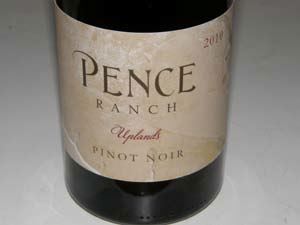 2010 Pence Ranch Estate Uplands Santa Barbara County Pinot Noir 14.5% alc., 295 cases, $40. From two producing East Blocks. Pommard and 115. 15% whole cluster. Aged 22 months in 1-year and older French oak barrels. Unfined and unfiltered. · Moderately dark reddish-purple color in the glass. Very giving nose offering aromas of red and black berries, exotic spices and a hint of peppery herbs. Very satisfying flavors of dark berries with hints of spice, vanilla and smoky oak. Nicely balanced and easy to cozy up to, leaving behind a pleasant impression. Still pumping out the aromas and flavors the following day from a previously opened and re-corked bottle. Plenty of Pinot singing here.
2010 Pence Ranch Estate Westslope Santa Barbara County Pinot Noir 14.5% alc., 94 cases, $50. From three producing West Blocks. 667, Swan and 828. These blocks are exposed to significant wind and have heavier soils than the East Blocks. 15% whole cluster. Aged 22 months in 1-year and older French oak barrels. Unfined and unfiltered. · Medium reddish-purple color in the glass. Very pretty aromatics with plenty of pure dark red cherry and just the right touch of oak. Soft and inviting on the palate with a discreetly concentrated core of dark red cherries and berries, finishing with a surge of cherry fruit with just a hint of oak. About the same the following day from a previously opened and re-corked bottle. Very good.
Cruzin’ the Pinot Trail: Pinot Paradise in the Santa Cruz MountainsThere is no other wine region even remotely like the Santa Cruz Mountains. It is one of the cradles of Pinot Noir in California, but is better known for its eccentric and Bohemian residents than its viticultural heritage. The reasons for this are evident when you cruz throughly the hilly, heavily wooded landscape. Unlike every other major winegrowing region in California, wineries and vineyards are not visible from major highways and roads. Vineyard sites are often in rugged, remote areas, tucked into a nook or cranny among the heavily forested countryside or perched on a hilltop accessible only by a length and precariously narrow road. Guideposts and signage directing visitors to wineries is nonexistent and locals quickly remove even the smallest roadside placard. Roads often zigzag and traversing them is agonizingly slow. Speaking of zigzag, the low-key residents of the Santa Cruz Mountains often have more interest in the crop you can smoke than the one you can drink. The Santa Cruz Mountains American Viticultural Appellation (AVA) was federally approved in 1981, and was one of the first AVAs to be defined by geophysical, altitudinal and climatic factors. The eastern and western boundaries are defined by elevation, namely mountainous land above 400 feet on the western side and from 400 to 800 feet on the eastern side. The squiggly outline of the Santa Cruz Mountains AVA reflects the fog line that surrounds the mountains.
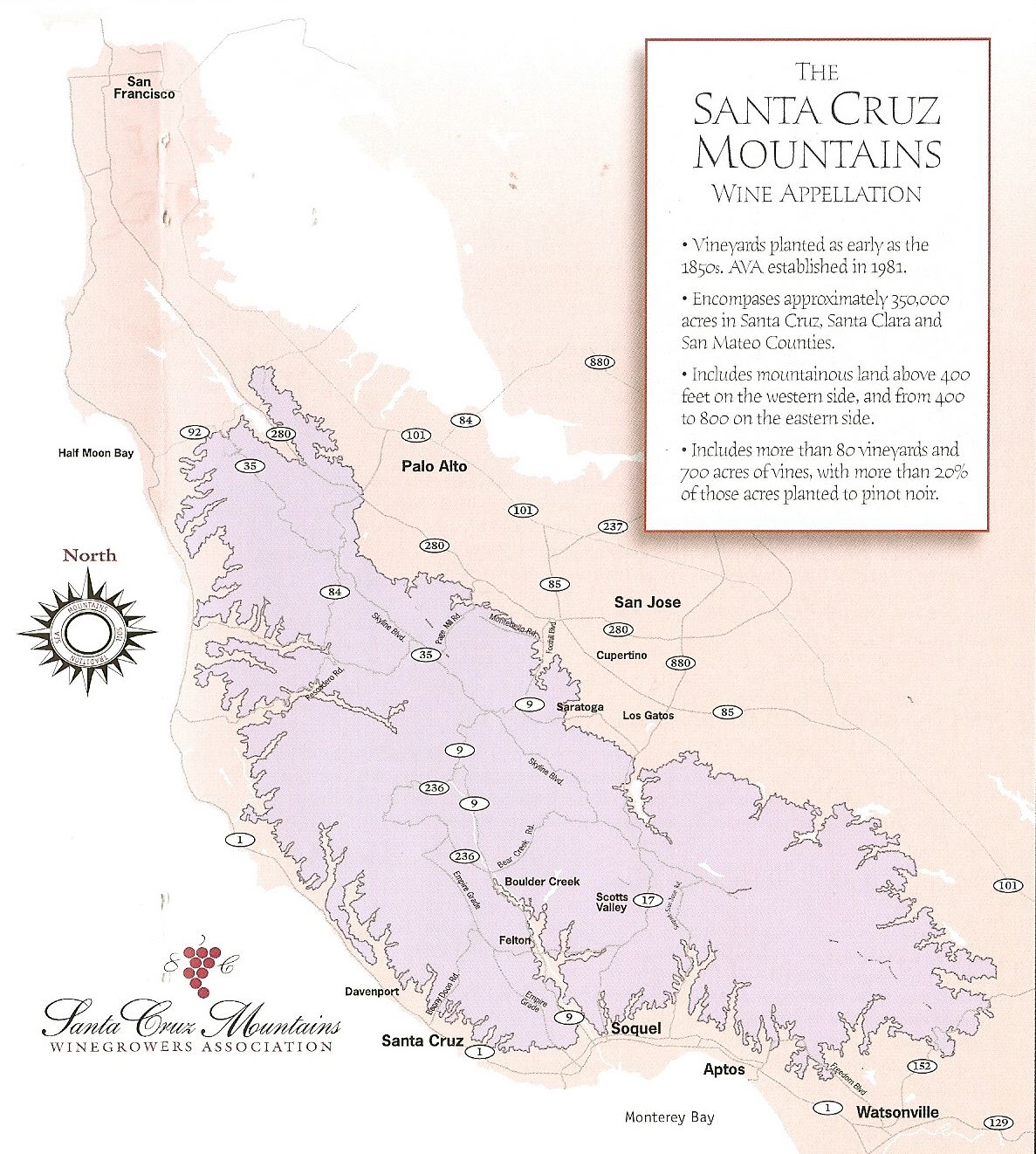 This large appellation stretches over 408,000 acres incorporating parts of three counties: Santa Cruz County to the west, Santa Clara County to the east, and San Mateo County to the north. It can easily take two hours (about 100 miles) to drive from one end of the AVA to the other. The Santa Cruz Mountains AVA is not included in the Central Coast AVA (but part of Santa Cruz County is). There are many small family owned vineyards (over 200) and wineries (90+), and the total vineyard acreage reported by the Santa Cruz Mountains Winegrowers Association is roughly 1500 acres divided evenly among Pinot Noir, Cabernet Sauvignon, Chardonnay and other varieties such as Merlot and Zinfandel. (Exact, up-to-date figures for vineyard acreage, number of vineyards and wineries is unavailable in keeping with the laid back vibe in this region. Previous research done by me a few years ago indicated 600+ acres of Pinot Noir). A single vineyard in some California appellations have as much if not more acreage than the Santa Cruz Mountains has in its entire AVA. The largest commercial vineyards are between 40 and 60 acres. As you can imagine, wine grapes are a scarce commodity and in considerable demand. There are a myriad of microclimates in the Santa Cruz Mountains, but wine grapes are planted in three general climates: (1) coastal vineyards are typically at lower elevations with fog burning off late in the morning, (2) high mountain and summit vineyards are above the fog, (3) valley slopes on the eastern side of the mountains along the peninsula which are warmer. The AVA has been further divided into six sub-regions according to flavor profiles. One of the six, Ben Lomond Mountain is a true sub-AVA of the Santa Cruz Mountains. The other five are Saratoga/Los Gatos, Summit Road, The Coastal Foothills (Los Ranchos), and Corralitos/Pleasant Valley. For more information visit www.appellationamerica.com/wine-review/645/Renaissance-Grape.html. An approximation of the sub-regions is illustrated below.
 Since the Santa Cruz Mountains are relatively isolated and have no large corporate involvement, they wines have retained a charming innocence and purity, seemingly unaffected by the trends that drive the sales of large wine producers. The wines are characterized by an earthy, mineral quality, complex and intense flavors, and balanced acidity that allows them to age well. There are few vestiges of the style of Pinot Noirs of the 1970s and 1980s when many Santa Cruz Mountains Pinot Noirs were rustic, chunky and tannic, and often poorly crafted. Today, the Pinot Noirs, led by producers such as Alfaro Family Vineyards & Winery, Big Basin Vineyards, Mount Eden and Domaine Eden, Rhys Vineyards, Windy Oaks Vineyards & Winery, Thomas Fogarty Winery and Varner & Neely, are thoroughly modern in style with commendable value-to-price ratios. A major reason for the modernization of Pinot Noir from this region is due to the widespread use of current viticultural know how. A number of experienced vineyard consultants, including Prudy Foxx and Greg Stokes, are actively assisting clients in choosing appropriate sites and aspects, planting the proper rootstocks and clones to match the sites, overseeing proper trellising, canopy management, and emphasizing sustainable vineyard practices. The result has been a notable improvement in wine quality.
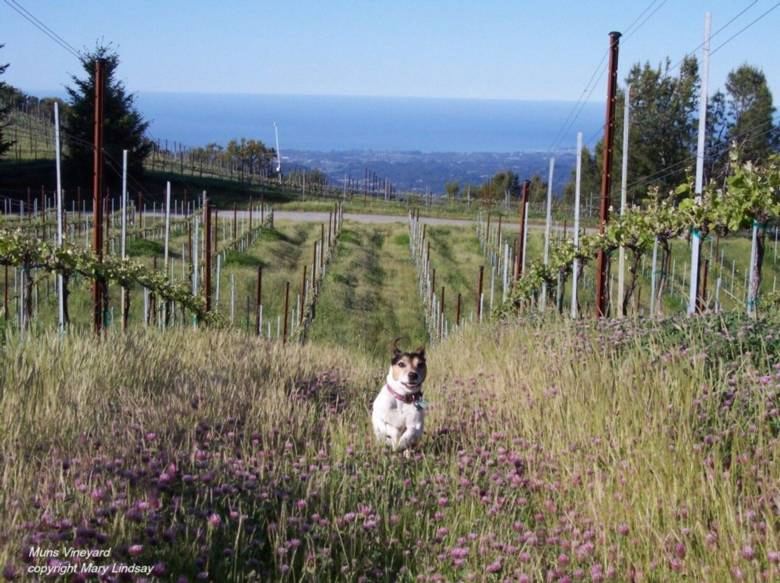 This quote from the book, Sideways, seems to be referring to Santa Cruz Mountains Pinot Noir. “It’s a hard grape to grow....it’s thin-skinned, temperamental, ripens early....it’s not a survivor like Cabernet, which grow anywhere and thrive even when it’s neglected. No, Pinot needs constant care and attention....it can only grow in these really specific, little, tucked-away corners of the world.” One of the challenges of the organizers of Pinot Paradise is to enlist more participation by Santa Cruz Mountains Winegrowers Association (SCMWA) members. There is an apparent lack of cohesiveness among winery members. Of the 80 wineries listed in the latest SCMWA brochure, only 35 participated in the Grand Cruz Tasting held on Sunday, March 24. Prominent members who were absent included Bonny Doon Vineyard, Clos de la Tech, David Bruce Winery, Loma Prieta, McHenry Vineyard, Rhys Vineyards, Salamandre Wine Cellars,Testarossa, and Windy Oaks Estate. Well-regard Pinot Noir producers Neely and Varner are not listed as members of SCMWA and did not participate. I attended the Pinot Paradise Technical Session on “Minerality - Taste and Terroir” held at the historic Mountain Winery in Saratoga. This was originally Paul Masson’s winery named La Cresta, that was completed in 1905. It was destroyed by the San Francisco earthquake a year later, but by 1907 a new winery stood in its place. Masson became quite successful until Prohibition intervened. By the time of Repeal in 1933, Masson, now a widower (he was married to noted vintner Charles Lefranc’s daughter, Louise), had lost most of his fortune and in 1936 sold his winery to Martin Ray. Since then the ownership of the property has changed hands numerous times. In 1958, an amphitheater was built on the grounds and The Mountain Winery became known for its Summer Concert Series. The current owners of The Mountain Winery have dedicated themselves to protecting the natural beauty of the estate. Many events and weddings are now held at the venue. The Mountain Winery also produces Pinot Noir and Chardonnay from estate grapes under the direction of winegrower Jeffrey Patterson of Mount Eden. The moderator of the “Minerality- Taste and Terroir” seminar was David Glancy, a wine educator and founder of the San Francisco Wine School. Panel winemakers included Duncan Meyers of Arnot-Roberts Winery, Bradley Brown of Big Basin Vineyards, Nathan Kandler of Thomas Fogarty Winery & Vineyards and Jim Schultze of Windy Oaks Estate Vineyards & Winery. Each of the panelists presented a wine intended to show minerality. It is always challenging to attempt to taste wine while a seminar is in progress, but for me, although all wines showed bright acidity, the Thomas Fogarty wine was the only wine to reveal minerality.
2012 Arnot-Roberts Legan Vineyard Barrel Sample Santa Cruz Mountains Pinot Noir Vineyard nonirrigated, planted in the 1980s at a cold, windy location at 1,500 feet elevation in the Corralitos sub-region. Well-drained sandy loam soils with considerable fine crushed rock. Site shows hi acidity and low fruit transparency. Yield 1.5 tons per acre. 100% whole cluster, foot crushing, ambient yeast fermentation, aged in 5-year-old French oak barrels. Low sulfur levels. · Nose has a confected, carbonic character. Flavors veer to dark red and purple fruits with mild tannins and nervy acidity.
2010 Big Basin Vineyards Woodruff Family Vineyard Santa Cruz Mountains Pinot Noir A dry-farmed vineyard located in the Corralitos sub-region, planted over 30 years ago. Elevation is 400 feet. Soils are sandy loam. 25% whole cluster, aged 15 months in primarily transparent French oak barrels. · Deep reddishpurple color in the glass. Aromas of dark berries with a slight green note. Flavors of blackberries and plum with a hint of tarry oak in the background. Bright acidity. Delicate finish that has some length. Good.
2010 Thomas Fogarty Winery & Vineyards Windy Hill Vineyard Estate Santa Cruz Mountains Pinot Noir A hilltop vineyard in the skyline sub-region at 2,000 feet that is cool and rocky. Soils are fractured sandstone. A challenging site for ripeness. Yields less than 1 ton per acre. Last bottling from original plantings which are Martini and Bruce selections. New plantings have closer spacing with a different orientation to reduce exposure to the brutal winds. 100% whole cluster, ambient yeast fermentation, aged in once-used French oak barrels. No sulfur added after malolactic fermentation. 50 cases. · Aromas of fresh purple grapes, spice and petrichor. Vibrant on the palate with dark berry, spice and grape flavors, clothed in fine-grain tannins with well-integrated acidity. Exceptional.
2010 Windy Oaks Estate Vineyards & Winery Henry’s Block Santa Cruz Mountains Pinot Noir Sourced from estate vineyard’s original plantings, 17th leaf (1996), Wädenswil clone in the Corralitos sub-region. Clay soils with underlain sandstone, that have low nutrients and lead to low vigor. Very cool, rugged terrain with significant maritime influence. 50% native yeast, 25% whole cluster, long fermentation of 39 days, over 17 months in barrel. 104 cases. · Nicely perfumed with aromas of dark cherries, spice and nutty oak. Moderately full and rich featuring bright flavors of fresh black cherries with hints of mocha and hazelnut. Very vivid fruit with an intense, long finish.
Josh Jensen of Calera Wine Company was scheduled to speak on minerality after the panel presentation, but illness prevented him from attending. His winemaker, Mike Waller filled in and presented three wines. Waller noted that because of the large percentage of whole cluster in Calera wines, the added potassium elevates the pH and acid must be added. The Calera wines definitely showed minerality.
2009 Calera Ryan Vineyard Mt. Harlan Pinot Noir 14.1% alc.. 2500 feet elevation. Aged 18 months in 30% new French oak barrels. · Lovely aromas of fresh cherries, rose petals and spice. Earthy, with flavors of black cherries and dark berries. The muscular, chalky tannins stand out. Good
2009 Calera Selleck Vineyard Mt. Harlan Pinot Noir 14.1% alc.. Aged 17 months in 30% new French oak barrels. · A more serious wine of tremendous interest. Aromas of cherries, blueberries, sandalwood, spice and sandstone. Delicious middleweight flavors of dark cherries and berries. Very smooth on the palate with less bitter tannins than the Ryan and more depth and length on the finish. Exceptional.
NV Calera Mt. Harlan Chardonnay 2200 feet elevation. Native yeast fermentation, aged 10 months in 30% new French oak barrels. · This wine is less about fruit and more about acidity and salinity. Flavors of lemon, white peach and roasted nuts. Impressive balance. Very good.
The Grand Cruz Tasting was held in Campbell at the Villa Regusa event center. Each year participating wineries offer a 3.0 L bottle for a silent auction to raise money to support SCMWA. In addition, a cuvée of vintages 2007 through 2011 of 36 Santa Cruz Mountains wineries was offered at auction. SCMWA president Dave Moulton of Burrell School Winery is shown holding the cuvée.
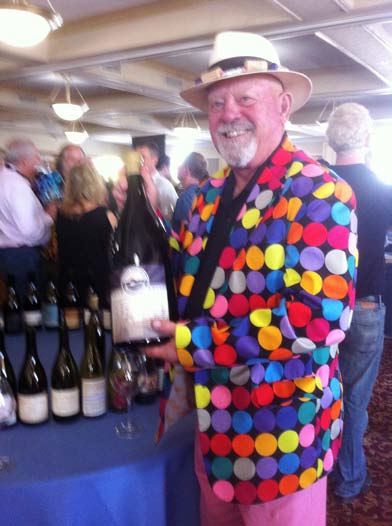 Before opening to the public, a pre-tasting was available to members of the press and trade and I was able to sample a number of wines from the 35 participating wineries. Here are the wines at the Grand Cruz Tasting that caught my fancy with brief tasting impressions.
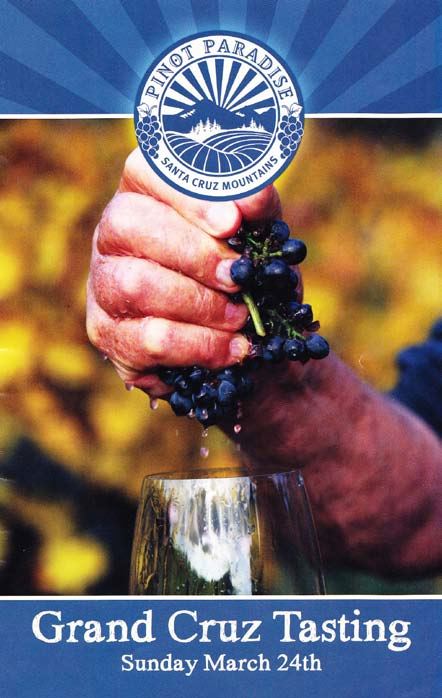 I tasted a mini-vertical of Pinot Noirs from Muns Vineyard. Ed Muns farms a 13-acre vineyard that is the highest in the Santa Cruz Mountains at 2,600 feet. Soils vary from rich loam to shale to red clay. Planting occurred from 1998 to 2005 with Dijon clones 114, 115, 667 and 777. Farming is sustainable and impeccable. 90% of production is sold to prominent producers including Beauregard Vineyards, Silver Mountain Vineyards, Sonnet, Soquel Vineyards and Thomas Fogarty. The Muns Vineyard wines were first produced in 2003 and are crafted by owner Ed Muns and winemaker Tony Craig. All the wines are 100% de-stemmed, whole berry fermented, aged in Hungarian oak barrels and are unfined and unfiltered. Common threads in the wines are red cherry fruit, bright acidity and firm tannins. Ed predicted the 2012 vintage will be terrific as there was no rain, harvest occurred on schedule, and the grape chemistries were perfect.
2006 Muns Vineyard Santa Cruz Mountains Pinot Noir 13.9% alc., pH 3.47, TA 0.66, 380 cases, $40. Aged 17 months in 33% new Hungarian oak barrels. · Very savory nose showing aromas of dried herbs and red cherry. Has held its age well with good vibrancy, offering light weight flavors of red cherries, nutmeg spice and savory herbs. Good.
2007 Muns Vineyard Santa Cruz Mountains Pinot Noir 14.5% alc., pH 3.50, TA 0.81, 380 cases, $40. Aged 17 months in 33% new Hungarian oak barrels with lees stirring. · Deeper, reddish-purple color. A gregarious wine with a very ripe fruit nose and rich flavors of dark cherries and sassafras. Robust with firm, but balanced tannins. Good.
2008 Muns Vineyard Santa Cruz Mountains Pinot Noir 14.6% alc., pH 3.51, TA 0.91, 165 cases, $40. Aged 17 months in 30% new Hungarian oak barrels with lees stirring. · Appealing aromas of delicate red fruits, savory herbs and vanillin oak. Middleweight flavors of juicy black cherries with an enticing accent of brown spices including cinnamon and a slight mocha note. Refreshing cut of acidity on the finish. Very good.
2009 Muns Vineyard Santa Cruz Mountains Pinot Noir 14.1% alc., pH 3.52, TA 0.74, 242 cases, $40. Released November 2012. Ideal growing conditions this vintage with yields of 3 tons per acre. Aged 17 months in 33% new Hungarian oak barrels with lees stirring. · Pleasing aromas of black cherries, red plums and roasted nuts. Delicious mid-weight flavors of dark stone fruits with a subtle riff of spice. The tannins and acidity are nicely balanced and this wine drinks seamlessly. My favorite. Exceptional.
2010 Muns Vineyard Santa Cruz Mountains Pinot Noir Unreleased, not reviewed.
2011 Muns Vineyard Santa Cruz Mountains Pinot Noir 80 cases, $40. Released November 2012. Two versions of Muns Vineyard Pinot Noir were made in 2011: one is the usual style crafted by Tony Craig and the other (tasted here) was made by winemaker Ryan Beauregard using native yeast and aged 8 months in second use American oak barrels. · Wild and exotic on the nose featuring delicate red cherry fruit and a hint of volatile acidity. Slightly confected red cherry flavor with hi-tone acidity and soft tannins. For the adventurous. Decent.
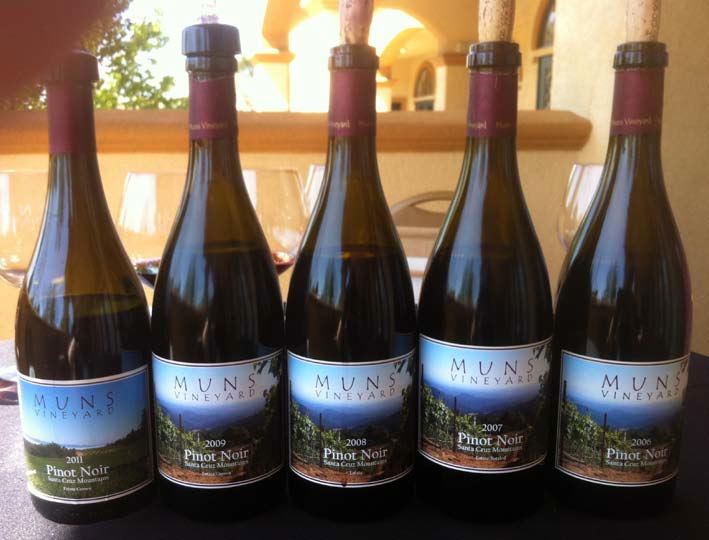
2010 Alfaro Family Vineyards Alfaro Family Estate Vineyard Santa Cruz Mountains Pinot Noir 13.5% alc., 188 cases, $35. Aged 17 months in 50% new French oak barrels. · An impressive wine with attentiongrabbing black cherry and spice flavors, supple tannins, and a finishing presence that keeps returning for an encore. Still showing significant oak imprint at this young age but this will improve over time. A tremendous value and one of my favorites at the Grand Cruz Tasting. Very good.
2010 Big Basin Vineyards Alfaro Family Estate Vineyard Santa Cruz Mountains Pinot Noir 13.4% alc., 150 cases, $44. Aged 16 months in 50% new French oak barrels. 30% whole cluster. · Very light, soft and ephemeral with appealing flavors of raspberries and cherries. Very good. The 2009 vintage was available for tasting to compare and was much bigger with more fruit concentration and tannin. I preferred the 2010 vintage.
2009 Big Basin Vineyards Lester Family Vineyard Santa Cruz Mountains Pinot Noir 14.1% alc., 193 cases, $44. 15% whole cluster. Aged 16 months in 50% new French oak barrels. Unfined and unfiltered. · Deep, dark reddish-purple color in the glass. Aromas of blackberry jam and plum cake with a touch of oak. Full-bodied and plush, with intensely flavorful blackberry and black plum fruit backed by firm tannins and complimentary oak. Impressive concentration but not excessively weighty. Very good.
2009 Burrell School Vineyards “Principal’s Choice” Estate Reserve Pinot Noir 14.4% alc., pH 3.3, TA 0.72, 340 cases, $45. Aged 18 months in 80% new French oak. · There is a very appealing core of luscious dark fruit with a vivid acid spine, but the fruit is buried in oak. Good. The 2010 vintage was also offered and is more to my liking with apparently less new oak. This wine shows less ripeness, is more red cherry-driven with spot-on vibrancy. Very good.
2011 Cinnabar Santa Cruz Mountains Pinot Noir 13.5% alc., pH 3.65, TA 0.61, 125 cases, $N/A. Sourced from Pleasant Valley vineyards. Aged 11 months in 40% new French oak barrels. · Very up front drinker, light in weight but flavorful with bright cherry flavors underlain with nutmeg and cinnamon spice. Impressive for this vintage. Very good.
2010 Clos Tita Estate Santa Cruz Mountains Pinot Noir 14.5% alc., pH 3.9, TA 0.6, <100 cases, $36. Clones 15, 777, 113 and 114. 15% whole cluster. Aged 23 months in 50% new French oak barrels. · This wine was a stand out among all those tasted at the Grand Cruz Tasting. Amazing dark fruit purity that attacks the mid palate with a vengeance, coats every nook and cranny in the mouth, and leaves a lasting impression. Still sporting muscular tannins and will benefit from more bottle age, but this is a knock out, especially at this modest price. Exceptional.
2010 Domaine Eden Santa Cruz Mountains Pinot Noir pH 3.30, TA 0.81, 1,537 cases, $35. Harvested at 23.9º Brix. Clones 828, Calera, Mt Eden, Swan, 667 and 777. Aged 12 months in 50% new French oak. · A forward drinking wine offering tart, red cherry flavor with bright acidity. Decent.
2010 Mount Eden Estate Santa Cruz Mountains Pinot Noir pH 3.45, TA 0.85, 804 cases, $N/A. Harvested at 23.5º Brix. Aged in 70% new French oak barrels. · One of the flagship wines of the Santa Cruz Mountains AVA. A connoisseur’s wine with class and sophistication. Still young, but showing vivid red fruits with good concentration, lively acidity, and a polished, focused finish that displays the electricity associated with minerality. Beautiful integration of oak. Exceptional.
Pleasant Valley Vineyards Winemaker Craig Handley was pouring three Pinot Noirs from Lester Family Vineyards in Corralitos, about a miles from his winery. Soils are sandy. 100% de-stemmed, whole berry, fermented in small lots. Aged in 50% new and 50% 1-year-old French oak barrels.
14.5% alc., pH 3.75, $48. Clone 667. Harvested at 24º Brix. Aged 18 months in French oak barrels. · This wine features nicely ripened purple fruits. Soft and smooth on the palate with a noticeable oak imprint that will integrate over time. Good (+).
14.5% alc., pH 3.70, $48. Clone 115. Harvested at 24.5º Brix. Aged 18 months in French oak barrels. · A nicely crafted wine displaying delicious dark red stone fruits and spice. Very forward with supple tannins. Very good.
14.0% alc., pH 3.64, $54. Clones 667 and 115. Harvested at 24.2º Brix. Aged 18 months in French oak barrels. · Middleweight purple berry and plum fruit core wrapped in soft tannins. Soft, velvety mouth feel. A charming wine with appealing finesse and balance. Very good.
2012 Sante Arcangeli Family Wines Barrel Sample. Sourced from a Corralitos vineyard. Very few 2012 samples were available for tasting at the Grand Cruz Tasting but this one really stood out. Aged in 70% new French oak barrels and still showing significant espresso oak topcoat, the fruit is nevertheless stunning. I was less impressed with the challenging 2011 vintage of this wine which was much more austere.
For information on the wineries of the Santa Cruz Mountains, visit SCMWA at www.scmwa.com or phone 831-685-8463. For information on the vineyards of the Santa Cruz Mountains, visit the Viticulture Association of the Santa Cruz Mountains (VASCM) at www.vascm.org. For extensive information on the Santa Cruz Mountains winegrowing region also visit the PinotFile at www.princeofpinot.com and enter “Santa Cruz Mountains” under the Google search feature. Santa Cruz Mountains Passport Day will be Saturday, April 20, 2013, presented by SCMWA. Santa Cruz Mountains Vintner’s Marketplace will be held at Santana Row in San Jose, California on April 21, 2013. Similar to a farmer’s market, this event allows you to sample and buy wines from the Santa Cruz Mountains. Over 20 Santa Cruz Mountains wineries will participate, including Beauregard Vineyards, Burrell School Vineyards, Muns Vineyard, Silver Mountain, Storrs Winery and Windy Oaks Estate. Admission will be free but wine tasting requires purchase of tickets. Visit www.scmwa.com for information. Oops, the event is sold out! Santa Cruz Mountains Vintners’ Festival will be June 1-2 and 8-9, 2013. The first weekend features wineries of Santa Clara and San Mateo counties and the second weekend wineries of Santa Cruz County. Tickets are now available at www.scmwa.com. A good source of Santa Cruz Mountains wines is the wine bar and retailer, Vinocruz, located at 725 Front St., #101, in Santa Cruz. Visit www.vinocruz.com.
Cruzin’ to Windy Oaks Estate Vineyard & WineryIt has been a couple of years since I lasted visited proprietor Jim Schultze at Windy Oaks. Windy Oaks farms 26 acres of Pinot Noir divided among 15 acres on the main winery site first planted in 1996, 7 acres nearby, and 4 acres in Aptos. Jim proudly showed me his new plantings of Chambertain selection and cuttings from previous Burgundy selection plantings that had been cleaned up by microshoot technology (photo below).
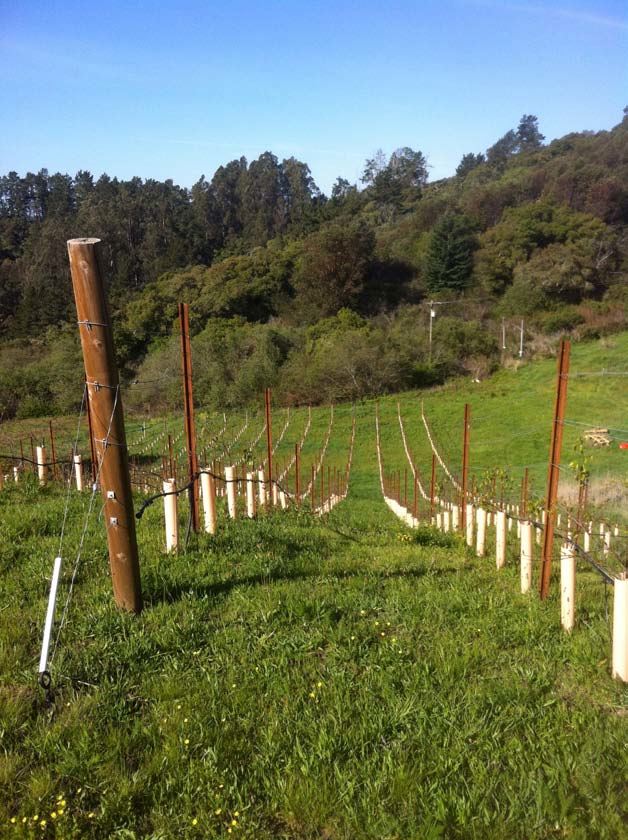 The photo below shows the aspect of Windy Oaks Estate, overlooking Monterey Bay in the distance and situated mostly above the fog line. This is a very cool, rugged site exposed to maritime weather. The growing season is one of the longest in California, often extending well into October or even early November. The vines, clones 115, 667, 777, 828, 2A, Pommard, and Burgundy selections, are meticulously farmed.
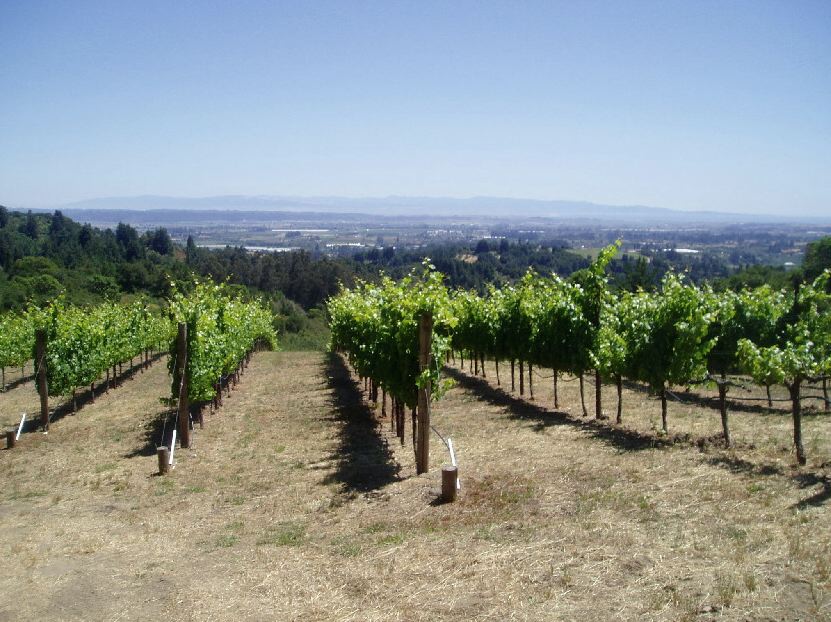 Jim directs all the vineyard management and winemaking. He likes to say, “I do the most I can in the vineyard and the least I can in the winery.” Jim’s two sons are now actively participating in the winery as well. Son Spencer Schultze also crafts a small amount of Pinot Noir from a neighboring vineyard under the “Eleven” label. Most fermentations use 50% ambient yeast and last an incredibly long 30 to 45 days. 25% to 30% whole cluster is the rule since the stems are often ripe, but Jim produces a limited amount of 100% whole cluster Pinot Noir. Jim is obsessive about his oak regimen and travels to Burgundy each year to meet with coopers. He uses 3-year-old air-dried tight-grained French oak barrels exclusively. Typical, he ages the wines for 17-27 months in 35% new oak with larger percentages in certain bottlings. His compact winery has all the toys for proper Pinot Noir vinification including a basket press and a modern bottling line. A new project, “Windy Oaks Whites,” will feature tank-fermented Sauvignon Blanc, Chardonnay, and Pinot Gris from purchased non-estate grapes priced in the $17 to $22 range. The first vintage will be 2012. Windy Oaks sells a high percentage of their wine directly to an active mailing list and visitors to the tasting room located on the property which is open Saturdays, 12:00 to 5:00. Wine club members receive significant discounts. Visit www.windyoakestate.com. I tasted through several 2010 Windy Oaks Estate Pinot Noirs and the 2010 Chardonnay. Jim told me farming was very challenging in the 2010 vintage, but the wines turned out well. I couldn’t agree more.
2010 Windy Oaks Estate Terra Narro Schultze Family Vineyard Santa Cruz Mountains Pinot Noir 13.8% alc., 374 cases, $29. Entry-level, value-priced wine composed of most blocks from the estate vineyard. Aged 17 months in 35% new French oak barrels. · A very pleasant wine, aromatic and flavorful, light in body with supple tannins, featuring red cherry and cranberry fruit, a hint of oak, and a citrus-imbued cherry finish. Good.
2010 Windy Oaks Estate Diane’s Block Schultze Family Vineyard Santa Cruz Mountains Pinot Noir 13.9% alc., 192 cases, $45. From a 5-acre block, all estate, at a lower elevation. Clones 115 and 667. Aged 17 months in 0% new oak. Always a favorite of women. Unusual in this cool vintage. · Slightly carbonic nose, with aromas of flowers and berries. Fruit-forward, featuring cherry and raspberry with some spice and savory herb notes. Light, with little finishing power. Decent.
2010 Windy Oaks Estate Wild Yeast Schultze Family Vineyard Santa Cruz Mountains Pinot Noir 13.8% alc., 123 cases, $55. 100% wild yeast fermented. Aged 18 months in 40% new French oak barrels. Tasting room or wine club members only. · Attention-grabbing nose of spiced cherries and sandalwood. A bit exotic and leesy, with considerable nuance. Very elegant and dreamy on the palate. Exceptional.
2010 Windy Oaks Estate 100% Whole Cluster Santa Cruz Mountains Pinot Noir 13.8% alc., 191 cases, $55. Wine club and tasting room only. Focus on clone 667 with some 115. Aged 17 months in 60% new French oak barrels. Very long fermentation. · Very complex nose offering scents of dark cherries, dried rose petals, baking spices, and herb garden. Highly approachable, with a very savory character offering flavors of mushrooms, smoky herbs and earthy fruits. Very good.
2010 Windy Oaks Estate Proprietor’s Reserve Santa Cruz Mountains Pinot Noir 13.8% alc., 364 cases, $60. From the 1.5-acre Bay Block of the original 3-acre vineyard. Available to wine club members and through the tasting room. Aged 22 months in 55% new French oak barrels. A barrel selection. Primarily Pommard 5 and 115. · Rather shy but appealing nose with scents of cranberries, pomegranates and black cherries. More fruit concentration and the biggest, longest finish in the lineup. I like this wine for its power without weight and excellent integration of oak. Exceptional.
2010 Windy Oaks Estate One Acre Santa Cruz Mountains Chardonnay 13.9% alc., $39. Barrel fermented for a minimum of 15 months in French oak barrels. Unfined and unfiltered. Reviewed at home. · Golden straw color in the glass. Aromas of lemon, flint, iron, croissant and oak. Creamy on the palate, with refined flavors of fresh citrus fruits, peaches on the grill, vanilla cream, oak and a touch of iron. Very soft in the mouth with nicely integrated acidity. Less fruit-driven than previous vintages, but more refined, sophisticated and mineral-inspired. Score: 94
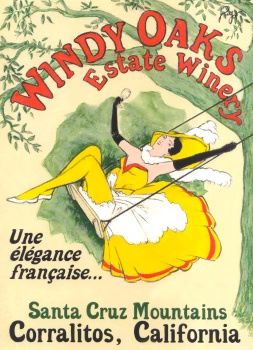
Spelunking & Tasting at Rhys VineyardsRhys Vineyards winery facility, opened in 2010, is located inside a 30,000 square foot cave on Skyline Blvd. in the Santa Cruz Mountains. There is nothing like this 10,000-case state-of-the-art winery in the region and it is almost breathtaking in scope. Grapes enter through one cave door, meet with modern sorting and destemming equipment, and progress to 120 (eventually to be 150) 1-ton stainless steel fermenters in mobile pods. Efficiency is the goal, with the winery laid out in a fashion to avoid moving equipment. Water, compressed air and glycol are available everywhere. The result is that the entire harvest can be managed with a small crew. After fermentation, the wines are sent to barrel storage wings of the cave monitored carefully for humidity to avoid concentrating the wines and artificially elevating alcohol percentages. Wines are not racked after barreling until blended for bottling and all wine flow is by the gentle push of bulldog equipment. The finished wines are packed for shipping in a devoted wing of the cave, and wines leave through a second exit cave door. The modest cave entrance shown below belies what is inside.
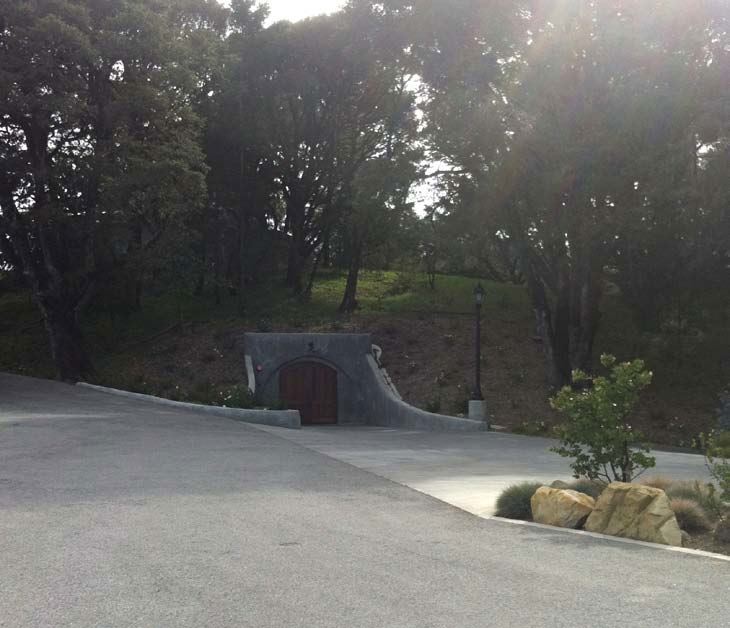
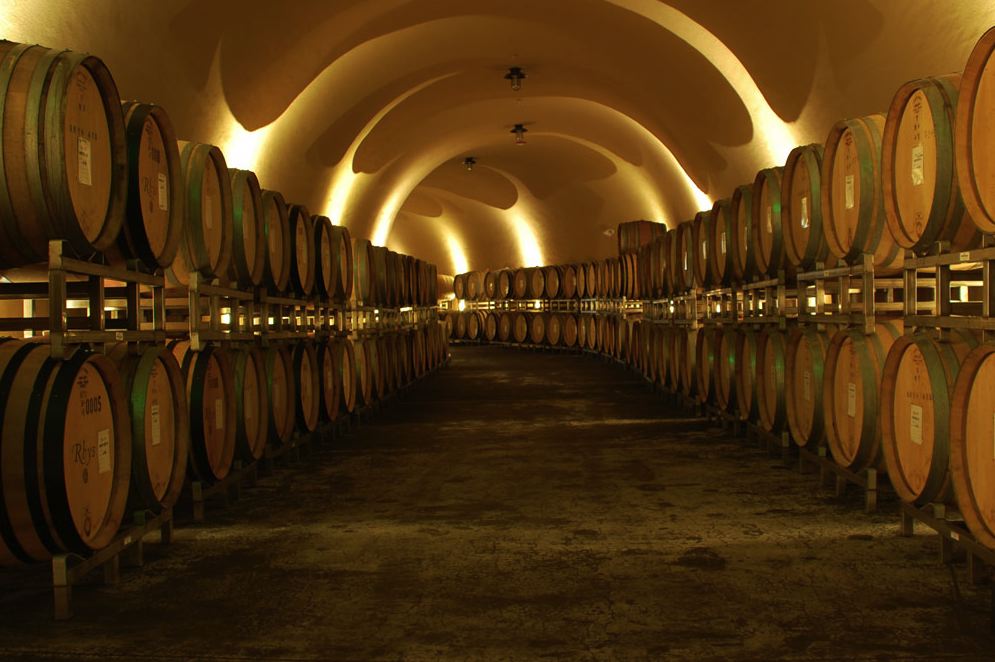 The name, Rhys, is derived from the Welsh spelling of Reese. Owner Kevin Harvey has five diverse vineyards with distinct geological profiles in the Santa Cruz Mountains Two vineyards, Family Farm and Home, are technically just outside the Santa Cruz Mountains AVA but produce wines that are Santa Cruz Mountains in character. The other three vineyards are Alpine, Skyline and Horseshoe Ranch. The first estate vineyard Pinot Noir release came in 2004, and the 2007 vintage was the first in which all five vineyards were in production. A sixth vineyard in the Santa Cruz Mountains AVA, with 18 plantable acres, is currently named Pajaro Vineyard after the Pajaro soils at the site. Acquired and planted more recently, it is located very close to Windy Oaks Estate in Corralitos, and will produce its first commercial harvest in 2015 or 2016. Plantings of Pinot Noir and Chardonnay here are very high density (3.5' x 2' and 3.5' x 3'). A seventh estate vineyard, Bearwallow, is located in the deep end of the Anderson Valley and contains existing Dijon clones planted in the manner common several years ago combined with newer more high-density heritage clone plantings. All Rhys vineyards meet important criteria: shallow soils which limit vigor, soils that are iron-rich, markedly fractured and rocky subsoils which allow vine roots to penetrate deeply, moderate clay content and limited water holding capacity, steep non-forested slopes, higher elevations, and a cool climate. Harvey is a firm believer that higher, rockier sites with thinner soils produce wines with more desirable minerality. Yields from grapes grown in these conditions are typically very low. Harvey has shunned the newer Dijon clones for the most part and instead planted heritage selections such as Calera, Swan, La Tache, Hyde and Wente. In time, vines are identified that produce optimal quality at each vineyard site and some vines are re-grafted with cuttings from these best performing vines. The result is a selection massale or mixture of selections. Rootstocks are Riparia and 120A, known for having the lowest rigor. Rhys Alpine Vineyard is shown below.
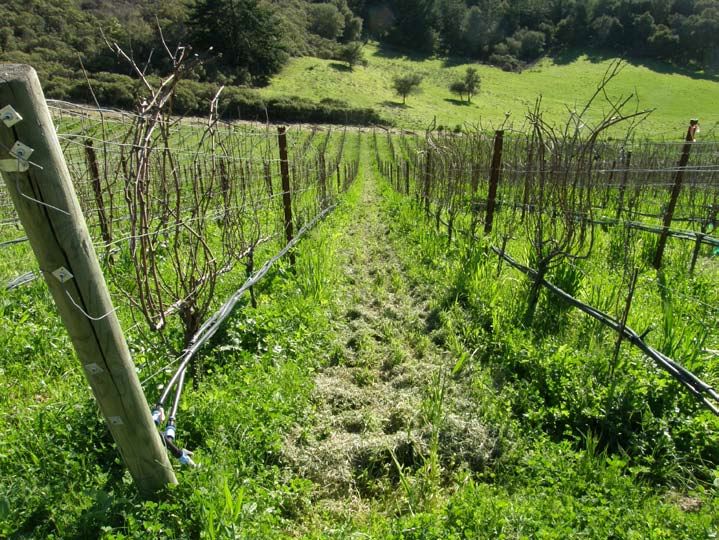 Picking is done over a several day interval to obtain grapes of variable ripeness, usually in the lower Brix ranges. Grapes are often placed 100% whole cluster in 1-ton fermenters, but the percentage of whole cluster can vary depending on the experiential history with each vineyard. Harvey says about whole cluster, “When it works, it always makes a better wine.” All fermentations are by ambient yeast, and punchdowns are carried out by foot treading. The wines are pressed off with a basket press and gravity fed into 4-year air-dried Francois Fréres French oak barrels. Wines spend approximately 14 months in barrel after which time they are blended. The percentage of new oak varies but is modest. All wines are unfined and unfiltered. Rhys Pinot Noir is not only distinctive for the Santa Cruz Mountains, it is unique among wines in North America. The wines are generally between 12.5% and 13.5% alcohol, but exhibit ripe fruit phenolics. They show no intrusion of oak and have well honed acidity. They are serious wines with many botttlings showing fresh fruit upon entry, but finishing with minerality. A goal at Rhys is to avoid the sweet fruit finish that is common among many California Pinot Noirs, especially those made from deep, fertile soils. The high percentage of whole cluster adds nuance and age ability. Winemaker Jeff Brinkman and Harvey have gradually refined their winemaking based on experience with their sites. For example, the 2007 and 2008 vintage wines had a prolonged period during which they were closed. The 2009 and 2010 vintage wines have not shown that propensity and it is assumed that this is due to subtle winemaking changes such as cool ferments and less extraction. The Rhys Pinot Noirs drink better early since the 2009 vintage but should age just as well. Harvey invited me to taste the 2011 Rhys wines from bottle in the confines of the Rhys cave. I feel quite fortunate to have this experience for two reasons. First, there is a two year waiting list to get on the mailing list to buy Rhys wines (yields were high in 2012 and more people will be added to the mailing list for that vintage). Second, the 2011 production was pitifully low, 25% of normal. Harvey remarked that his next newsletter offering the 2011 wines will be titled, “Never have we fought so hard for so little.” He said 2011 was “California at its coolest.” The wines had been bottled just a few weeks prior. The small amount of wine that was produced is impressive. The Pinot Noirs have plenty of aromatic, flavor and textural interest and there are no sweet, cloying finishes. I also tasted the Horseshoe, Swan Terrace and Skyline 2012 Pinot Noirs from barrel and I won’t torture you with my superlatives. All I can say, this is a Goldilocks vintage where everything is just right. Quantity and quality are equal. Buy every bottle of 2012 Rhys Pinot Noir you can get your hands on! Because production was so low in 2011, the Alesia label (Rhys wines made from purchased grapes) was revived in a search for grapes from a vineyard site that fit the Rhys profile. Alder Springs Vineyard in northern Mendocino County was chosen. Situated at 2,500 feet, is quite rocky with sparse topsoils. Chardonnay is one of the most popular wines from Rhys. Normal production is about 700 cases, but this will increase with new plantings at Bearwallow and Pajaro vineyards. The Chardonnays are barrel fermented with no lees stirring since Harvey believes this makes Chardonnay “blurry.” Selections are primarily Wente and Hyde with small amounts of Dijon 76 clone. You need to look elsewhere if you want ripe, leesy, buttery and oaky Chardonnay.
2011 Rhys Vineyards Horseshoe Vineyard Santa Cruz Mountains Chardonnay Aromas of lemon curd, apple, and wet stones. Restrained flavors of citrus fruits, green apple and quince with bright acidity on a sharply focused finished. Very classy, very good.
2011 Rhys Vineyards Alpine Vineyard Santa Cruz Mountains Chardonnay More aromatic with a slight tropical fruit scent complimenting the lemon notes. Complex, with flavors of lemon meringue, pineapple, vanilla cream and nuts. An hi-tone cut of acidity underlies the fruit and leads to a refreshing, dry finish. Very good.
Family Farm and Home vineyards are but 350 to 400 yards apart with similar climates, comparable clones, but they lie in different geological zones and are completely distinct wines from one another. The Home Pinot Noir is exotic with typically aromas of an Eastern spice bazaar. The 2011 vintage is the first to include new plantings at the Home Vineyard which are of higher density with better rootstock and clone combinations. Harvey says the Home “would be a good addition to a Burgundy blind tasting.” Whole cluster is a little too pronounced at 100% with the Family Farm vineyard.
2011 Rhys Vineyards Family Farm Vineyard San Mateo County Pinot Noir 12.8% alc.. 60% whole cluster, aged in 40% new French oak. · Aromas of grilled plum, earth, smoke and peat. Relatively undeveloped and closed, showing some appealing dark berry and smoky plum flavors with restrained, fine-grain tannins. Good.
2011 Rhys Vineyards Home Vineyard San Mateo County Pinot Noir 13.2% alc.. 100% whole cluster, aged in 10% new French oak. · Highly perfumed with exotic spices including cardamom. Juicy and satisfying on the palate, featuring darker stone fruits and berries. The whole cluster really compliments the fruit. Finishes with a dry, focused finish that sports a hint of iron and loam. Exceptional.
2011 Rhys Vineyards Skyline Vineyard Santa Cruz Mountains Pinot Noir 50 cases from 14,000 vines or 1 bottle per 25 vines! Usually 100% whole cluster, but cautious in this vintage and reduced to 67%. Price was raised in this vintage and some complained, but everyone asked for more. Harvey calls this a “superstar” vineyard. The Syrah from this vineyard is superb, but the Pinot Noir is so amazing that the Syrah is being grafted over to Pinot Noir. · This wine has it all: highly flavored dark berry and plum fruit, tons of spice, plenty of minerality, beautiful balance, supple tannins, and a focused finish. Exceptional.
Horseshoe and Alpine vineyards were tasted in tatum as they close together with the same climate. The soils, however, are quite different, and the resulting wines from each vineyard are dissimilar. This is a good example for demonstrating the role of terroir, specifically soils. Wines from Horseshoe display considerable minerality, both the Chardonnay and Pinot Noir. The Horseshoe wines were great initially, then declined for a couple of years, and now have returned to greatness with the 2012 vintage. Harvey calls the wines from Horseshoe Vineyard “more intellectual and introverted.” Alpine Vineyard Pinot Noir, on the other hand, has its assets as well but does not show as much minerality. A subsection of Alpine, Swan Terrace, is usually bottled separately and is often my favorite among all the Rhys Pinot Noirs, but was included in the Alpine bottling in 2011.
2011 Rhys Vineyards Horseshoe Vineyard Santa Cruz Mountains Pinot Noir 0% whole cluster. · Slight reduction on the nose, disappearing slowly in the glass as fruit appears. The most striking feature of this wine, beyond the delicious dark berry, tea and spice flavors, is the very dry and distinct finish. If you wanted to choose one wine to show a person what “minerality” is, this wine would be a top choice. Exceptional.
2011 Rhys Vineyards Alpine Vineyard Santa Cruz Mountains Pinot Noir 0% whole cluster. · Darker fruits with exotic spices and camphor are featured on the nose. Not as showy as the Horseshoe, with more modest fruit expression at this stage. Flavors of dark plum, Hoison, and blackberries with a smoky undertone. The wine is sporting muscular tannins that need time to soften and integrate. Very dry, well-defined finish. Very good.
2011 Rhys Vineyards Bearwallow Vineyard Anderson Valley Pinot Noir Made from existing plantings of Dijon and Pommard clones. 8’ x 5’ spacing, planted 12 years ago. Almost no new oak, very little whole cluster. · Fragrant with fresh berry compote and vanilla. Juicy acidity elevates the dark berry, plum and pomegranate flavors which end with noticeable presence on a focused, tight and gritty finish. Very good.
2011 Alesia Alder Springs Vineyard Mendocino County Pinot Noir 40% whole cluster, 45% new French oak. · Deep reddish-purple color in the glass. Aromas of black raspberries and spice. Slightly rustic with black fruit flavors and firm, balanced tannins. Very earthy, showing tastes of iron. Enters with good attack and exits in a slippery fashion with a bright cut of acidity on the finish. Unique. Good (+).
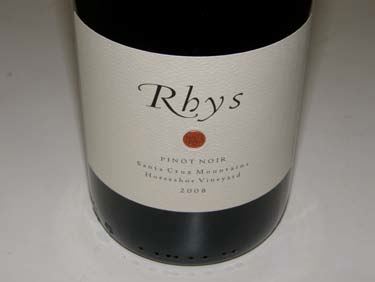
Sips of Oregon Pinot Noir: Recently Sampled Wines
2011 Antica Terra Botanica Willamette Valley Pinot Noir 13.2% alc., $75. · Moderate reddish-purple color in the glass. Shy aromas of black cherries, rosebush and flint. Middleweight flavors of black cherries, black raspberries, cola and rose water, with a flowery undertone. Well-balanced ripe tannins and a focused, chalky finish leaving behind a lively fruit impression. Not the drive, extract and power we have come to expect from Shea Vineyard in this vintage, but still a wine of interest. Tasted the following day from a previously opened bottle, the nose was very perfumed and flowery with hints of oak and spice, the wine was smooth and soft on the palate, and some appealing spice had been added to the flavor profile. Very good.
2011 Big Table Farm Willamette Valley Pinot Noir 12.6% alc., 519 cases, $38. A combination of new, once used and neutral barrels from all Pinot Noir sites. Some aspect of whole cluster and the result of sur lie aging. · Moderately light reddish-purple color in the glass. Very fragrant with scents of red cherries and wild strawberries. Fresh, bright and refreshingly juicy with flavors of red cherries, raspberries on the vine, watermelon, and toasty oak. Light and delicate, but charming with electric acidity. The best Willamette Valley bottling from Big Table Farm in a few years. Good (+).
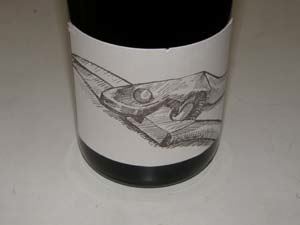 2011 Big Table Farm Pelos Sandberg Vineyard Eola-Amity Hills Willamette Valley Pinot Noir 12.6% alc.,$45. A collaboration with Don, Johanna, Lynne and Perry who farm this vineyard. · Moderately light reddish-purple color in the glass. The nose opens gradually, revealing aromas of dark cherries, violets, spice and brewed tea. Very satiny and seamless on the palate with a tasty core of fresh cherry fruit enhanced with accents of savory herbs. Modest weight, with very supple tannins, leaving behind a combination of cherries and green salad on the finish. I like this wine a lot for its easy manner. A very admirable effort in this difficult vintage. Very good.
2009 CAW Yamhill-Carlton District Willamette Valley Pinot Noir 14.9% alc., $36. · Medium reddish-purple color in the glass. This wine reflects the relatively warm 2009 vintage in the Willamette Valley. Aromas of black cherries, tomato and beet. Flavors of black plum, black cherry and raisin. Plenty of concentration with balanced tannins, but lacks the verve that Oregon Pinot Noir is known for. Too ripe for my taste. Decent.
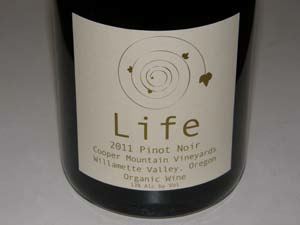 2011 Cooper Mountain Vineyards Life Willamette Valley Organic Wine 13.0% alc., 200 cases, $35. Aged in 30% new and 40% second-use French oak barrels. No sulfites added during winemaking. Certified organic by Oregon Tilth. Biodynamic® by Demeter®. This bottling began as an experiment in 2002, but has become very popular. Consumers are advised to drink this wine upon acquisition, although the winemaker believes it will hold up well for short-term aging. · Moderately light reddish-purple color in the glass. Very fruity nose featuring bright aromas of cherries, strawberries and red fruit punch. Flavorful and forward, offering tastes of dark red and blue berries, red plum and a complimentary savory herb note. The tannins are well managed and the acidity brings life to the fruit. An excellent food wine in a Beaujolais style. Good.
2010 ROCO Marsh Estate Vineyard Yamhill-Carlton District Willamette Valley Pinot Noir 13.5% alc., $50, screwcap. Vineyard owned and farmed by Doug and Pat Marsh. Clone 115 and Pommard on Riparia rootstock, irrigated, planted in sedimentary sandstone, sustainably farmed. · Light garnet color in the glass. Aromatic, with clean scents of cherries, tea leaf and compost. Light in weight and easy to drink, but the flavors of woody cherry, red berry, black tea and green leaf don’t particularly appeal. Decent.
2010 ROCO Private Stash No. 8 Chehalem Mountains Willamette Valley Pinot Noir 13.5% alc., $70, screwcap. From Wits’ End Vineyard. · Light garnet color in the glass. Shy, but pleasant aromas of dark cherries and berries. Delicious core of red fruits with accents of spice, sassafras, graham and nutty oak. Juicy, elegant and charming, displaying balanced fine-grain tannins and a short, but satisfying finish. Interesting textural magic. Noticeably lighter in this vintage. Very good.
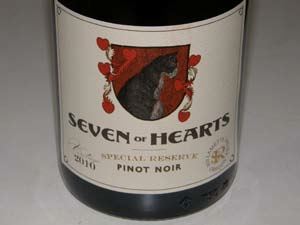 2010 Seven of Hearts Special Reserve Willamette Valley Pinot Noir 13.5% alc.,112 cases, $42. A blend of several vineyards in the Yamhill-Carlton, Eola- Amity Hills and Chehalem Mountains AVAs. Volcanic and sedimentary soils. Clones 114, 115, 667, 777, Pommard, Wädenswil and Mariafeld. Aged in 27% new French oak barrels. · Moderately light reddish-purple color in the glass. Shy, but pleasant aromas of black cherry preserves and musk. Well-endowed with a core of delicious dark cherry and dark red raspberry flavor. Silky and seamless on the palate with restrained tannins and noticeable finishing power. The wine is slow to evolve in the glass and was considerably better the following day from a previously opened and re-corked bottle. Decant if you must drink now. Very good.
Sips of California Pinot Noir: Recently Sampled Wines
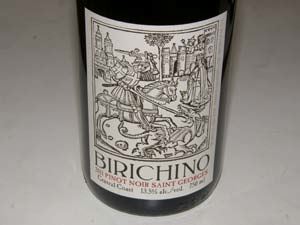 2011 Birichino Saint Georges Central Coast Pinot Noir 13.5% alc., $18.99, screwcap. Pronounced “biri-kino,” and meaning naughty or mischievous in Italian. This winery was founded in 2008 by Bonny Doon alumni Alex Krause and John Locke. Ambient yeast, a dollop of whole cluster, elevage in neutral barrels and unfiltered. Sourced from a vineyard just below the southern end of the Santa Cruz Mountains. · Medium reddish-purple robe in the glass. The nose is rich with aromas of well-spiced berries and cherries. Elegant, but flavorful, offering a mix of fruits including dark cherries, purple grapes, and raspberries. Supple tannins and a dry, but shallow finish. Nicely crafted and easy to like, but lacks the complexity that oak brings to the mix. Still, I would gladly drink this any day with dinner. Good (+).
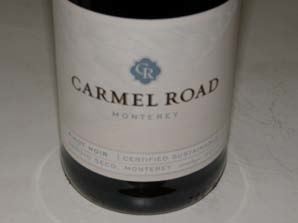 2011 Carmel Road Monterey Arroyo Seco Pinot Noir 13.5% alc., pH 3.67, TA 0.56, 27,000 cases, $22. Panorama, Clark and Mission Peak vineyards certified sustainable by SIP since 2008. Clones 667, 777, 115, 2A and 23. Aged 9 months in 96% French oak (16% new) and 4% American oak (3% new). · Medium reddish-purple color in the glass. Extremely appealing aromas of black cherries, black raspberries, spice and fresh rose petal holding up over time in the glass. Tasty mid-weight core of dark red cherry and berry flavors with the slightest toasty oak in the background. Very easy to like with a sense of plushness on the palate and admirable balance. Unbelievable quality considering the huge production. Widely available. Very good.
2010 Cerridwen Van der Kamp Vineyard Sonoma Mountain Pinot Noir 14.4% alc., 84 cases, $54. Inaugural bottling. This vineyard sits at 1400 feet elevation. Soils are loam with volcanic and decomposed river bed components. Yields 1.5 to 2.0 tons per acre. Grapes were hand de-stemmed and fermented with indigenous yeast. Clones 828 and 23. Aged 16 months in 100% French oak barrels with lees stirring. Unfined and unfiltered. Aged 12 months before release. Winemaker Deborah Bennett interned with winemaker Greg La Follette and worked a harvest in New Zealand before crafting her first wine. · Moderately light reddish-purple color in the glass. Slight reduction upon opening blows off. Aromas of fresh, hi-tone cherries and cherry pit leading to lighter-weight flavors of cherries, raspberries, cranberries and a slight pharmaceutical note, offering a backbone of dusty, dry mountain tannins, finishing very dry with a kiss of cherry. Tasted two bottles. Good.
2010 Chasseur Russian River Valley Pinot Noir 14.3% alc., pH 3.68, TA 0.61, 393 cases, $40. Unfined and unfiltered. Sourced from Holder, Ferguson and Sylvia’s vineyards. Aged 10 months in 50% new French oak barrels. · Medium reddish-purple color in the glass. Hi-tone aromas of fresh cherry pie glaze. Middleweight flavors of black cherries, cola, and subtle oak, noticeable on the attack and carrying over to the finish. Good concentration without weight. A solid appellation wine. Good.
2010 Chasseur Blank Russian River Valley Pinot Noir 14.3% alc., pH 3.65, TA 0.59, 118 cases, $60. Blank Road Vineyard is a collaboration between William Hunter and Kenneth Goodin. Clones 115 and 777.Aged 10 months in 67% new French oak barrels. Unfined and unfiltered. · Moderately dark reddish-purple color in the glass. More rugged, with darker fruits and more tannin. Aromas of blackberries and wooded forest. Flavors of black plum, black currant and tar with a good cut of acidity on the finish. Softly textured and well-crafted, but doesn’t quite deliver the flavor of other wines in the 2010 Chasseur lineup. Good (+).
2010 Chasseur Freestone Station Russian River Valley Pinot Noir 14.7% alc., pH 3.68, TA 0.71, 117 cases, $60. A collaboration between William Hunter and the Cleary & Dutton familes of Freestone Station Vineyard. Clones 114, 115 and 667. Aged 10 months in 67% new French oak barrels. · Moderately dark reddish-purple color in the glass. Fruit veers to the ripe side but never reaches over ripeness. Aromas of black cherries, forest floor, wet stones and anise. Mid weight flavors of dark red cherries and berries with accents of cherry cola, sassafras and cardamom spice. On the delicate side and light on its feet with admirable balance, picking up intensity and interest over time in the glass. A tad shallow on the finish. Very good.
2010 Chasseur Holder Russian River Valley Pinot Noir 14.7% alc., pH 3.63, TA 0.59, 77 cases, $60. A collaboration between William Hunter and the Holder family of Holder Vineyard. Aged 10 months in 67% new French oak barrels. · Moderately dark reddish-purple hue in the glass. Nicely perfumed with bright aromas of dark red and black cherries and berries with a hint of oak spice. Tasty essence of darker cherries and purple berries with a dash of sassafras and cola. Soft in the mouth and very enjoyable with mild, dry tannins, well integrated oak, and some finishing length. Very good.
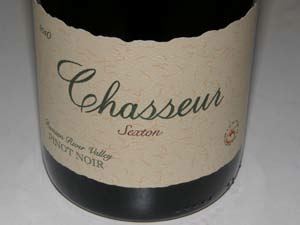 2010 Chasseur Sexton Russian River Valley Pinot Noir 14.1% alc., pH 3.69, TA 0.57, 100 cases, $60. A collaboration between William Hunter and Jim Pratt from Cornerstone Vineyard on Sexton Road. Dijon clones 113, 114 and 115. Aged 10 months in 67% new French oak barrels. Unfined and unfiltered. · Moderately dark reddish-purple color in the glass. The intoxicating nose really draws you into the glass with explosive aromas of Bing cherries and exotic spices. Delicious cherry essence with riffs of cola and spice. Ethereal, seamless and a wine that makes you sit up and take notice. Wow! The pick of the litter.
2010 Chasseur Umino Russian River Valley Pinot Noir 14.5% alc., ph 3.66, TA 0.61, 266 cases, $60. A collaboration between William Hunter and Davic Umino of Umino Vineyard. Aged 10 months in 67% new French oak barrels. Unfined and unfiltered. · Moderately dark reddish-purple hue in the glass. The scents of black cherries and dusty oak jump out of the glass. Very soft and smooth on the palate with a deep cherry flavor. A polished wine that is very Russian River Valley in character but with the typical lush fruit reigned in a bit for more charm. Tasted the following day from a previously opened and re-corked bottle, the wine was still exceptional. Beautifully crafted and one special wine.
2011 dept. C Chileno Valley Vineyard Marin County Pinot Noir 12.8% alc., pH 3.76, TA 0.56, $42. Clone 115. 100% de-stemmed, aged 11 months in 25% new French oak barrels. · Light reddish-purple color in the glass. Delicate aromas of red cherries, allspice and rose petals. Very light and demure cherry flavor with a trace of tarry oak and a green thread running through. Very soft tannins. Decent.
2011 dept. C Santa Lucia Highlands Pinot Noir 14.0% alc., pH 3.48, TA 0.60, $30. From the Paraiso Estate, clones 115 and 777. 100% de-stemmed, inoculated with RC 212 and Assmanhausen yeasts. Aged 11 months in 15% new French oak barrels before a single racking before bottling. · Medium reddish-purple color in the glass. First bottle showed aromas of fermented fruit and overripe melon (acetaldehyde). Decent core of dark red and black fruits, slightly sweet and candied in character, backed by caramelized oak, mild tannins and citrusy acidity. A flawed wine. Second bottle showed aromas of blackberries, plum and apple core (a hint of acetaldehyde). The dark fruit core was rich and very soft in the mouth and more appealing. Easy to drink with supple tannins and complimentary oak in the background. Very slight fault, but decent.
2011 Drew Morning Dew Vineyard Anderson Valley Pinot Noir 12.6% alc., $50. 50% whole cluster. · Moderately light reddish-purple color in the glass. Very shy fruit on the nose with a forest floor, bell pepper aroma. Bright red fruits are featured with excellent verve due to bright acidity and mild tannins. Darker berries, cherries and plum flavors are satisfying, complimented by a pleasing mouthfeel. Showing some whole clusterdriven savoriness and greenness now. Relatively closed and not at all like the stunning example I sampled from barrel last summer and more recently at In Pursuit of Balance. I would check back with this wine in 6 to 12 months. Withhold judgement.
2011 Failla Keefer Ranch Russian River Valley Pinot Noir 13.5% alc., $46. · Medium reddish-purple color in the glass. Shy aromas of red cherries and berries, oak, stem and balsam. Mid-weight flavors of red cherries with a savory herb and smoky oak accent in the background. Soft in the mouth with gentle tannins and bright acidity. Well-crafted, but doesn’t have the ripeness and stuffing I have come to expect from this stellar vineyard. I do like it for its femininity. Good.
2011 Failla Sonoma Coast Pinot Noir 13.5% alc., $35. · Moderately light reddish-purple color in the glass. Well-perfumed with fresh berry jam and spice. Middleweight flavors of black cherries and black raspberries which show good ripeness, backed by suave tannins and zingy acidity. The finish comes up a bit short. Not extraordinary, but a solid wine for the dinner table. Good.
2010 Fort Ross Fort Ross Vineyard Sea Slopes Sonoma Coast Pinot Noir 14.5% alc., $36. 100% de-stemmed. Aged 10 months in 24% new and 76% neutral French oak barrels. · Moderately light reddish-purple color in the glass. Upfront aromas of plum and wild berry fruits, sandalwood, spice, and moss. Tasty core of dark red stone fruits and berries with an underlying savory herb and dried flower note, wrapped in muscular, sinewy tannins. Lightest in concentration of the three Fort Ross 2009 Pinot Noirs tasted here but with an appealing dry, black cherry-driven finish. Good.
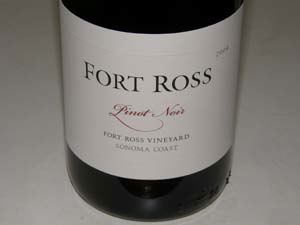 2009 Fort Ross Fort Ross Vineyard Sonoma Coast Pinot Noir 14.1% alc., pH 3.65, TA 0.63, 1,438 cases, $42. Dijon 115, 777, Pommard and heritage selections of Calera and Swan. 100% de-stemmed, aged in French oak barrels. Aged 10 months in 30% new French oak barrels. Unfined and unfiltered. · Moderately dark reddish-purple color in the glass. Aromas of black cherries, sassafras, soy sauce, seaweed and vanillin oak. Relatively full-bodied flavors of dark cherries and raspberries, root beer, brown spice and subtle oak. This wine has a definite minerality to it with an earthy, salty, soil-bound quality. A long finish adds to the appeal. Very good.
2009 Fort Ross Fort Ross Vineyard Reserve Sonoma Coast Pinot Noir 14.3% alc., pH 3.56, TA 0.55, 303 cases, $65. A barrel selection. 100% de-stemmed. Aged 10 months in 40% new French oak barrels. · Dark and inky in the glass. Very aromatic with scents of blackberry jam, plum pudding, dark red rose petals and seaweed. Compared with the regular Fort Ross Vineyard bottling, this wine has more concentration, more sweetness, more tannin, and more length on the finish. Dark-fruited with subtle spice, the sheer fruit volume tunes out most of the minerality. About as big as Pinot Noir gets without falling into the realm of Syrah. Bigger is not usually better for me, but to its credit, this wine is not jammy. Good (+).
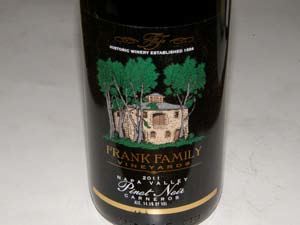 2011 Frank Family Vineyards Carneros Napa Valley Pinot Noir 14.5% alc., 26,300 cases, $35. · Moderately light reddish-purple color in the glass. Aromas of pine-scented oak, black cherries, ollaliberries and warm biscuit. Tasty with impressive fruit presence in a mid weight style featuring flavors of black cherries and black raspberries with a touch of spice and oak. Soft and smooth on the palate with some finishing persistence. Good (+).
2010 Gary Farrell Russian River Selection Russian River Valley Pinot Noir 14.1% alc., pH 3.45, TA 0.65, 6,842 cases, $42. Released December 2012. Sourced from multiple premium vineyards including Toboni, Hallberg, Floodgate and Rochioli. 100% de-stemmed, aged 8 months in 40% new French oak barrels. · The nose is quite charming, particularly for those who cherish Russian River Valley Pinot Noir. Aromas of Bing and Maraschino cherries, spice and brioche, with a slight confected tone. Mid-weight cherry core with a subtle oak riff and a crisp, citrus-driven finish. Elegant and pleasant with a refreshing tone. Good.
2010 Joseph Phelps Freestone Vineyards Estate Grown Sonoma Coast Pinot Noir 13.5% alc., pH 3.62, TA 0.60, 2,650 cases, $55. 50% Pastorale Vineyard and 50% Quarter Moon Vineyard. Clones 828, 459, 777, 667, 115, 113, Pommard and several heirloom selections including Calera, Swan, and Mt. Eden. Aged in 50% new and 50% two to three-year-old French oak barrels, light to medium toast. · Medium reddish-purple color in the glass. The aromas really draw you into the glass offering scents of black cherries, black raspberries, violets, exotic spices and a hint of stem in a good way. The flavors echo the nose with a complimentary touch of tobacco-laced oak. Full-bodied and intense, soft in the mouth, finishing with a grainy earthiness. Impressive concentration for this vintage. Highly approachable now. Much more interest than so many Dijon clone destemmed Pinots. Very good (+).
2010 Joseph Phelps Quarter Moon Vineyard Estate Grown Sonoma Coast Pinot Noir 13.5% alc., pH 3.62, TA 0.61, 1,130 cases, $75. 41-acre vineyard five miles from the Pacific coast at 500 feet elevation on a well-drained, steep hillside. Aged in 67% new and 33% two to three-year-old French oak barrels. · Moderately dark reddish-purple color in the glass. An ooh la la nose developing slowly over time revealing itself seductively. Aromas of cherries, Asian 5-spice and hibiscus. Rich and luscious dark red fruits are complimented by Asian 5-spice, backed by fine-grain, velvety tannins, and elevated with good acidity. Unbelievably long, focused and electric grand cru finish. Like the Energizer bunny, it keeps going and going.
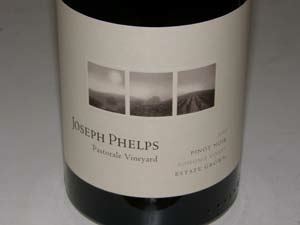 2010 Joseph Phelps Pastorale Vineyard Estate Grown Sonoma Coast Pinot Noir 13.5% alc., pH 3.53, TA 0.60, 550 cases, $75. This 34.5-acre vineyard surrounds the Freestone winery facility and is 8 miles from the Pacific coast. Aged in 70% new and 30% two and three-year- old French oak barrels. · Moderately dark reddish-purple color in the glass. Shy aromas of dark cherries and blackberries with subtle spice and oak highlights. Impressive concentration without weight, offering earthbound flavors of dark red and black fruits including purple grapes with a hint of spice and tobacco-laced oak. Impeccable balance and a finish that hangs on tenaciously. The next day when sampled from a previously opened and re-corked bottle, the wine had blossomed further, becoming an “Oh my God” wine.
2010 Joseph Swan Vineyards Cuvée de Trois Russian River Valley Pinot Noir 14.2% alc., $29. · Moderately light reddish-purple color in the glass. Slit reduction upon opening. Aromas of black cherry, oak cask, black tea leaf and stem with more fruit showing up over time. Juicy flavors of black cherries and dark berries that go down easy. A little earthy with a hint of citrus in the background. The flavor picks up intensity and interest over time in the glass. Good.
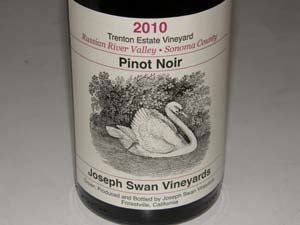 2010 Joseph Swan Vineyards Trenton Estate Vineyard Russian River Valley Pinot Noir 14.2% alc., 310 cases, $55. · Medium reddish-purple hue in the glass. Aromas of dark cherries, wooded forest and rose petals. Slightly lighter in this vintage but very flavorful featuring moderately full-bodied black cherry and plum fruits with signature spice. Restrained but evident tannins, a polished texture, and an exemplary finish. A little heat peaks out at the back end. Very good.
2011 La Crema Russian River Valley Pinot Noir 14.5% alc., pH 3.61, TA 0.56, RS 0.08%, 4,900 cases, $40. Focus on Laughlin and Piner Estate vineyards but grapes are sourced from diverse regions of the Russian River Valley including Green Valley, the Santa Rosa bench and the hills of Occidental. Clones are Pommard, 23, 777, 115, 667, 828, 2A and Martini. 100% de-stemmed, 70% whole berries, aged 10 months in 31% new French oak barrels. Racked once at blending before bottling. · Medium reddish-purple color in the glass. Very fragrant with an enticing perfume of black cherries, black berries and a hint of cardamom spice maintaining an intensity over time in the glass. Full-bodied and lush, with a delicious core of black cherry and cola flavor with a hint of toasty oak adding interest. Nicely balanced tannins, excellent acidity and some finishing length. One of the better Russian River Valley appellation wines tasted from this vintage. Very good.
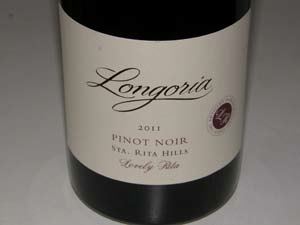 2011 Longoria Lovely Rita Sta. Rita Hills Pinot Noir 13.4% alc., pH 3.24, TA 0.69, 321 cases, $32. 100% de-stemmed, aged in 20% new French oak barrels. Unfined, lightly filtered. · Medium reddishpurple color in the glass. Wonderfully perfumed with aromas of black raspberries, black cherries and spice. Very tasty with flavors of red plum, pomegranate and black cherry with a hint of Asian 5-spice. Easy to drink with mild, dry tannins and bright acidity. A slight bit shallow in the mid palate attack and finish, but I would be happy to drink this wine anytime with a casual dinner. Good.
2011 Longoria La Encantada Vineyard Sta. Rita Hills Pinot Noir 13.6% alc., 50 cases, $50. Release May 2013. First vintage from this vineyard. Located directly across the valley from the Longoria estate Fe Ciega Vineyard. Dijon 777. 100% de-stemmed, aged 14 months in 30% new French oak barrels. · Moderate reddishpurple color in the glass. Shy fruit on the nose with primarily aromas of forest floor, tarry oak and cigar. Darker berry flavors are featured with hints of tar, earth, animale and tobacco, finishing with a plethora of fruit and length. Good.
2011 Longoria Bien Nacido Vineyard Santa Maria Valley Pinot Noir 13.6% alc., 73 cases, $45. Release May 2013. Rick has been producing this wine from the same eight rows in Block N since 1993. Martini clone. Aged 14 months in 30% new French oak barrels. · Moderately light reddish-purple color in the glass. Aromas of black cherries, wood shop and pine. Very flavorful on the palate with tastes of dark red berries and cherries underlain with dried herbs and oak. A charming wine that has supple tannins and a dry, lengthy finish. Needs some time in bottle to shed some of the oak topcoat. Good (+).
 2011 Longoria Fe Ciega Vineyard Block M Sta. Rita Hills Pinot Noir 14.5% alc., 53 cases, $60. Release May 2013. The first vintage from a block Rick planted in 2008. It is a 1.25-acre block located on the steepest part of the site and planted to Mt. Eden clone. · Moderately dark reddish-purple color in the glass. Brooding aromas of black plum and black grape. Ambrosial core of dark plum, berry and purple grape flavor with appealing hints of iron and spice. The fruit is striking and it carries over to an unbelievably intense and long blackberry-driven finish. The fine-grain tannins are more reserved in this vintage making the wine very approachable. One of the best wines I have had from this vineyard.
2010 Longoria Fe Ciega Vineyard Sta. Rita Hills Pinot Noir 13.9% alc., pH 3.69, TA 0.54, 430 cases, $48. 100% de-stemmed and crushed into open top fermenters. Inoculated fermentation averaging 12 days. Aged 15 months in 28% new French oak barrels. Unfined and unfiltered. · Medium reddish-purple color in the glass. A more delicate, red fruit themed vintage for this vineyard, yet highly appealing. Enticing aromas of cherries, pie crust, and wood spice. Soft and smooth in the mouth, with enchanting flavors of cherries, raspberries and oak vanillin. Balanced dry tannins and well-honed acidity, finishing with some respectable length. Extremely comforting and easy to like. Very good
2010 Merryvale Carneros Pinot Noir 13.5% alc., $30. · Moderately light reddish-purple color in the glass. The aromas are slow to emerge revealing delicate scents of cherry glaze and oak. Very soft in the mouth with mild tannins, featuring flavors of dark red cherries and raspberries. Nicely balanced and easy to drink, but lacks pizzazz. Decent.
2011 Pfendler Estate Grown Sonoma Coast Pinot Noir 13.7% alc., 275 cases, $45. From four estate vineyards located in the Petaluma Gap. Swan, Calera and Pommard selections. 100% de-stemmed, aged 8 months sure lie and 22 months total in 50% new French oak barrels. This wine celebrates the memory of Peter Pfendler who planted the first vineyards on the family ranch in 1992. · Moderately light reddish-purple color in the glass. Attractive aromas of fresh cherries and berries with a hint of tobacco oak and dried rose petal. Mid weight flavors of dark red cherries and berries with hints of cola, rhubarb and herbal oak, with a reasonably good black cherry presence on the finish. Light, elegant and very approachable, but just seems a tad flat and uninspired. Two bottles sampled. Good.
2011 Stomping Girl Lauterbach Hill Russian River Valley Pinot Noir 13.4% alc., pH 3.6, TA 0.52, 75 cases, $38. Released March 1, 2013. This vineyard is owned by Stew Lauterbach and farmed by Lee Martinelli, Jr. Pommard and Dijon clones. 100% de-stemmed, aged 11 months in 100% French oak barrels, mostly neutral. Unfiltered. · Moderately light reddish-purple hue in the glass. Sexy perfume of dark red cherries and berries with a hint of red licorice, rose petal and musk. Light and flush with finesse, featuring flavors of red cherries brought to life with vivid acidity. A slight green note of unripeness runs through. Good.
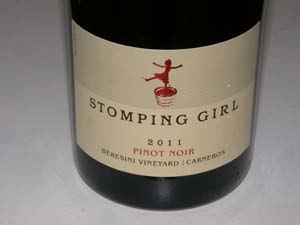 2011 Stomping Girl Beresini Vineyard Carneros Pinot Noir 14.2% alc., pH 3.50, TA 0.58, 150 cases, $36. Released March 21, 2013. Steve Beresini is a retired winemaker who worked alongside Andre Tchelistcheff and planted his own vineyard in 1989. Pommard, 777 clones and Calera selection. 100% dstemmed, aged 11 months in 100% French oak barrels, mostly neutral. · Moderate reddish-purple color in the glass. Aromas of black fruits, oak, mushrooms on the grill and bay leaf. Good concentration with tasty dark red and black fruits with a hint of toasted oak in the background. Lively acidity out paces the fruit, finishing with more acid than fruit on the finish. Good.
2011 Vaughn Duffy Suacci Vineyard Sonoma Coast Pinot Noir 13.1% alc., 29 cases, $40. Very meager yields in 2011. Dijon clones. · Moderately light reddish-purple color in the glass. Aromas of dark red berries, spice and smoky oak. Lean and acid-driven, with flavors of cranberries and unripe strawberries, lacking enough concentration to please and finishing very short. Decent.
Sips of Chardonnay: Recently Sampled Wines
2011 Arnot-Roberts Santa Cruz Mountains Chardonnay 12.7% alc., 300 cases, $30. · Pale light straw color and clear in the glass. Aromas of apple, pineapple, crushed wet stones and sap. Flavors of green apple and hi-pitched lemon with piercing acidity. An austere, acid-driven wine with a hint of salinity on the high voltage finish. Decent.
2010 Benovia La Pommeraie Russian River Valley Chardonnay 14.5% alc., $43. · Light straw color and clear in the glass. Moderately rich and very Russian River Valley in character, yet has enough restraint to appeal. Aromas and flavors of fresh apple, citrus, honey and brioche. Like biting into a juicy, ripe caramel apple on a stick. Beautifully balanced with just the right amount of oak.
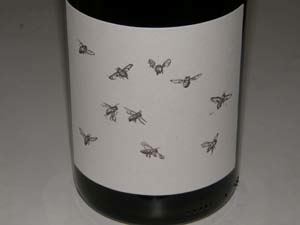 2011 Big Table Farm Willamette Valley Chardonnay 12.8% alc., 136 cases, $42. This is no surprise as Brian has worked extensively with Chardonnay at Neyers Vineyards and Marcassin in the past. 60% of the fruit is from Bieze Vineyard which shares a fence with Seven Springs Vineyard. The balance of the blend is from the Wirtz Vineyard which dates to the early 1970s. Barrel fermented in mixed aged French oak barrels. Unfined and unfiltered and not cold stabilized. Label is adorned with bees courtesy of Clare and her hives. · Light straw color and clear in the glass. Brilliant aromas of fresh applesauce, the air after a rain, and graphite. Appealing flavors of baked apples, pear and lemony citrus. Slightly creamy on the palate with a refreshing lift of acidity on the finish. Not a showy or dolled-up wine, put pure and modest. One of the better Chardonnays I have had from Oregon. Bring on the oysters!
2011 Chappellet Napa Valley Chardonnay 14.5% alc., pH 3.55, TA 0.64, $35. From the Kelly Ranch, a cool site in the rolling hills above San Pablo Bay and the Poe and Red Hen vineyards, farmed by the Laird family. Dijon clones 95 and 96 and Robert young clone. Winemaker Phillip Corallo-Titus, the winemaker at Chappellet for over twenty years. · Pale straw color and clear in the glass. Oak-infused aromas of yellow peach, lemon, pastry cream and blond caramel. Tasty core of lemon cream, baked pear and toffee. Slightly creamy with complimentary oak in the background. Good.
2010 Eric Kent Russian River Valley Chardonnay 14.5% alc.,pH 3.36, TA 0.62, 272 cases, $40. 86% Stiling Vineyard with small amounts of Wildcat Mountain and Green Acres Hill vineyards. Primarily Rued selection. · Light straw color and clear in the glass. Nuanced nose offering aromas of lychee, chestnut, banana, graphite and bark. Soft in the mouth and rather ordinary with flavors of pear, lemon, honey and roasted nuts. Decent.
2010 Gary Farrell Russian River Selection Russian River Valley Chardonnay 14.2% alc.,pH 3.22, TA 0.73, 2,752 cases, $35. Released August 1, 2012. Sourced from four Russian River Valley Vineyards. Aged 7 months in 40% new French oak barrels. · Light straw color and clear in the glass. Aromas of lemon curd, candle wax, bark and oak. A richer style with flavors of baked apple crisp, grilled citrus and toasty oak. The fruit has a very ripe, cooked quality typical of many Russian River Valley Chardonnays. A good backing of acidity saves the wine. Decent.
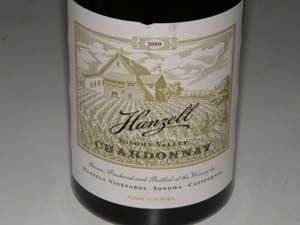 2009 Hanzell Sonoma Valley Chardonnay 14.5% alc., $75. · Very light straw color and clear in the glass. Initially reduction aromas of struck match, resolving over time to reveal scents of straw bale, alfalfa, autumn leaves and roasted nuts. A seamless wine that enters with tasty flavors of lemon, pear and peanuts and exits with a lemony riff. Slightly crusty and salty. Very good acid backbone leads the drinker to another sip. Finishes impressively with great vigor and focus. Should age extremely well.
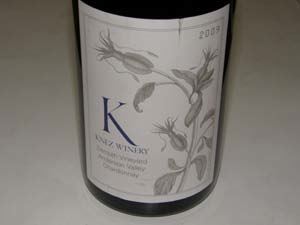 2010 Knez Demuth Vineyard Anderson Valley Chardonnay 13.2% alc., $37. · A very appealing wine that is not gussied up with oak and is highly flavorful. Lemon and green apple aromas and flavors are featured with a faint note of fresh brioche. Crisp, bright and refreshing, like biting into a ripe green apple. Very charming. This is a Grand Cru level old vine Chardonnay vineyard.
2010 Joseph Phelps Freestone Vineyards Estate Grown Sonoma Coast Chardonnay 13.5% alc., pH 3.38, TA 0.67, 2,910 cases, $55. Clones 76 and Wente. 100% malolactic fermentation. Aged 14 months in 50% new and 50% two to three-year-old French oak barrels. · Light straw color and clear in the glass. Understated, picking up interest over time in the glass. Aromas of tart lemon, straw, and buttered brioche. Reminds me of the smell of a bakery. Very tasty flavors of lemon and baked pear with complimentary buttery oak. Soft in the mouth, with a zesty finish leaving a long trail of steely lemon behind. Very good.
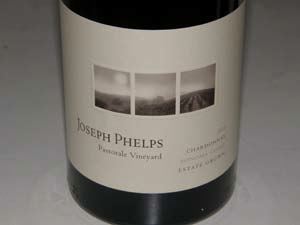 2010 Joseph Phelps Pastorale Vineyard Estate Grown Sonoma Coast Chardonnay 13.5% alc., pH 3.39, TA 0.62, 210 cases, $75. From the best block of Chardonnay planted at the Pastorale Vineyard in Freestone. 100% malolactic fermentation. Aged 14 months in 67% new French oak barrels (50% in 500 Liter puncheons). · Light straw color and clear in the glass. Delicate aromas of lemon peel, lime, oak and chalk dust. Restrained, but alluring with very nice balance. Offers an appealing fusion of apple and citrus flavors with the slightest nutty oak in the background. This wine has an understated appeal that keeps the drinker exploring for nuance. Very good.
2011 Pfendler Estate Grown Sonoma Coast Chardonnay 13.8% alc.,150 cases, $38. Partially de-stemmed and crushed to tank, barrel fermented, 8 months sur lee aging, 10 months in 40% new French oak barrels. Clone 4 and Hyde-Wente. Winemaker Greg Bjornstad. · Light straw color and clear in the glass. Nicely perfumed with aromas of apple crisp, lemon, brioche, pastry cream and chalk dust. Soft and pleasing on the palate with flavors of grilled peach, baked apple, toasted nuts and caramel with a slight riff of citrus. Nicely balanced with good integration of acidity and a clean finish. Good.
Pinot BriefsWinesong Charity Auction & Tasting Bradley Ogden returns as celebrity chef to this popular event on September 6-7, 2013 on the Mendocino Coast. The 29th Annual Winesong will offer “An Anderson Valley Pinot Noir Celebration” hosted by the Little River Inn on Friday, September 6. On Saturday, September 7, guests stroll through Mendocino Coast Botanical Gardens enjoying an array of wine and food from 100 highly acclaimed wineries and 50 top Northern California restaurants. The celebration continues with the Live and Silent Charity Auctions. Ogden will prepare the Live Auction Lunch. Bay Area celebrity Narsai David will serve as Master of Ceremonies. The mission of Winesong is to assist the small rural Mendocino Hopsital which supplies care to residents and visitors to the Mendocino Coast. Visit www.winesong.org or tickets.
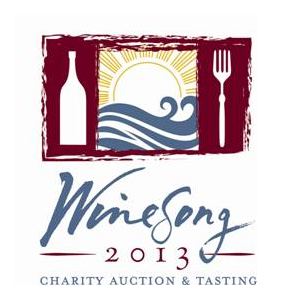 Pinot, Pigs & Poets. An annual charity event held June 6-7, 2013, in Omaha, Nebraska, that supports Completely KIDS’ after school and weekend food programs at area schools and shelters in Omaha and Council Bluffs. There is a Grand Tasting on June 6 with some of Omaha’s best chefs preparing food paired with Pinot Noir wines, a Vintner Competition for best wine, the Taste of Elegance Chef Competition, and performances by poets from the Nebraska Writers Collective. Participating wineries include Archery Summit, Benovia, Big Table Farm, Donum, Joseph Phelps Freestone, Morgan, Penner-Ash, Scherrer, Small Vines, Twomey and Williams Selyem. For information and tickets visit www.pinotandpigs.org.
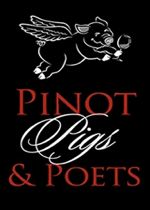 Passport to Pinot The Russian River Valley Winegrowers present the 2nd Annual “Passport to Pinot” barrel tasting weekend on June 8-9, 2013. More than 30 participating wineries including Davis Family Vineyards, Dutton-Goldfield Winery, Emeritus Vineyards, John Tyler Wines, Joseph Swan Vineyards, La Crema, Martin Ray Winery, and Sonoma-Cutrer Vineyards. The event includes barrel tastings, library tastings, food pairings, artists demonstrations, and futures purchases. On Friday night there will be a showing of “From Obscurity to Excellence: The Story of Grapes and Wine in the Russian River Valley,” a documentary by Joe Nugent, at Vintners Inn. For tickets and information, visit www.rrvw.org. Anderson Valley Pinot Noir Festival This 16th annual festival will be held May 17-19, 2013, in the Anderson Valley. Events include a Pinot Noir Technical Conference on Friday, May 17, (I will be speaking on faux clone 828), a Friday night BBQ at Scharffenberger Cellars, the Grand Tasting under the tent at Goldeneye on Saturday, May 18, Winemaker dinners Saturday night, and Winery Open Houses on Sunday, May 19. This event always sells out. Visit www.avwines.com for tickets.
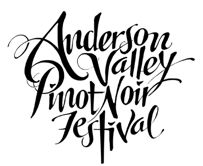 Ponzi Vineyards New Tasting Room A new, modern tasting room is set to open in Sherwood on Chehalem Mountain adjacent the Ponzi winery. Scheduled to open in June, the tasting room will have a lounge with wine service, a small plates menu, a fireplace, and views of the surrounding vineyards and countryside. Remains of Gallo-Roman Vineyard Discovered in Gevrey-Chambertain Science Daily (March 16, 2013) reported that excavations by the Institut National de Recherches Archéologiques Préventives (INRAP) found 316 rectangular hollow pits aligned in 26 rows, interpreted as the remains of a vineyard from the 1st century AD. The alignment and shape of the pits match those found at other sites of Gallo-Roman vineyards discovered in both southern France, the region around Paris and in the UK. These pits in Gevrey- Chambertain are the first signs of Gallo-Roman vineyards discovered in Burgundy. Oregon Still Means Pinot Noir Oregon, or as I like to say, “Noiregon,” held its Oregon Wine Industry Symposium in Portland on February 19, 2013. According to Wines & Vines (April 2013), Southern Oregon University professor Greg Jones reported a recap of Oregon’s vineyard acreage indicating that more than 61% of Oregon vineyards are planted to Pinot Noir. Christian Miller of Full Glass Research said, “Oregon still equals Pinot Noir.” Insulting Wine Brands Still Attract Women Buyers In the latest Wines & Vines (April 2013), the top 20 new table wine brands indicated that those that target women are big sellers. Skinnygirl from California is by far the top new seller at $4,755,489 in 2012, but others in the top 20 include Fancy Pants, Thorny Rose, Wine Sisterhood, Flirt, Ooh La La, Butterfly Kiss, and Flame Lily. Can cheap table wines targeting men be far behind? How about Ripped, Six Pack, Wine Brotherhood, Sharp Dressed Man, Stud, and Mover. Article on California’s Fort Ross-Seaview AVA An excellent article appeared in the Wine Enthusiast (April 2013) written by Steve Heimoff. The history of the region, an excellent map showing vineyard locations, vignettes of major producers from this one-year-old AVA, and a review of wines from the AVA are included. Oregon Senate Approves Wine Growler Bill Oregon now allows wine to be sold in refillable “growlers,” much like brewpubs sell beer. Consumers can fill up the reusable bottles with wine from airtight kegs at restaurants and retailers. Each keg saves about 39 bottles. Estimating BAC The Century Council, a national, independent not-for-profit organization funded by distillers, launched an interactive online program, “B4Udrink,” which offers the science to estimate an individual’s blood alcohol concentration (BAC). The new and revised algorithm for B4Udrink now includes the effects of height and age on an individual’s BAC, in combination with gender, weight, and type and number of alcoholic drinks consumed. The B4Udrink “Virtual Bar” also illustrates the effect food can have on an individual’s BAC, including how a meal high in fat has little effect on one’s BAC, yet a meal high in carbohydrates or protein may decrease an individual’s BAC. The new program is also mobile-friendly. The B4Udrink “Virtual Bar” gives people the ability to virtually explore different scenarios regarding how they might think their night will go, discover their drinking limits and plan accordingly. This information allows individuals to make educated, responsible decisions when going out socially. For more information about the B4Udrink program or to access the “Virtual Bar,” visit www.B4Udrink.org. Bill To Allow Alcohol References on Oregon’s License Plates Two years ago, Oregon’s legislature approved a specialized plate celebrating the state’s wine culture. The plate pictures grapevines and has been popular. House Bill 3471, would allow alcohol references on wine country vanity plates like GR8 PNO, FYN WYN and PNOGEK. Stay tuned. Interview with Jeremy Seysses of Domaine Dujac An entertaining interview of Jeremy Seysses, co-proprietor of Burgundy’s Domaine Dujac in Morey-Saint-Denis. Tyler Colman caught up with Seysses at the recent La Paulée New York. Posted at www.wine-searcher.com/m/2013/04/q-and-a-jeremyseysses- domaine-dujac.
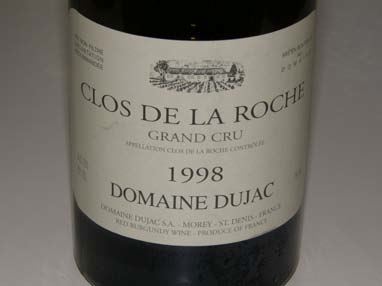 Wine Information Search Engine Search 26 million pages and 41 million sites of trustworthy wine information at www.ablegrape.com. This is not a site to shop for wine, but a site for learning and research. With filters to help you discover things faster, I have found this an invaluable search engine to find authoritative and up-to-date online wine, enology and viticulture information.
 Tune in to Grape Radio for a Good Time There have been a number of very entertaining podcasts on Pinot Noir posted on Grape Radio recently and they can be heard now or downloaded to your iPod for listening in the car. Check out the following programs at www.graperadio.com.
Show #320 A Walk Through Burgundy, Allen Meadows at the 2012 International Pinot Noir Celebration
Composing the PinotFile
 Anyone out there guess how much time it takes to compose each issue of the PinotFile? 8 hours, 16 hours, 32 hours. Wrong!! How about 45 hours minimum ($1.29 an hour). Hey, what gives, this is a full-time job and I am supposed to be retired.
Step 1: Taste many wines, including both marginal examples of Pinot Noir and incredible Pinot Noir.
|